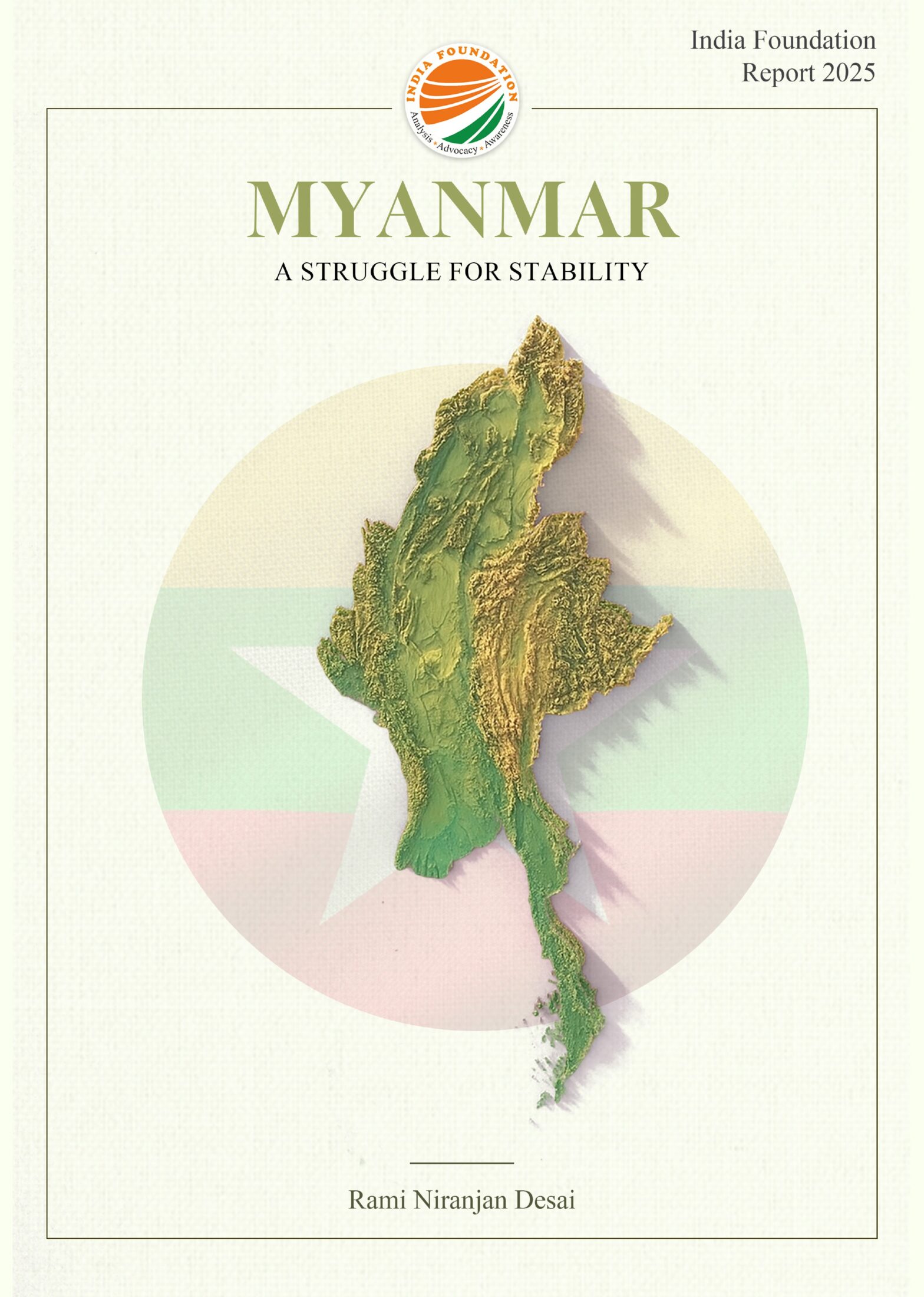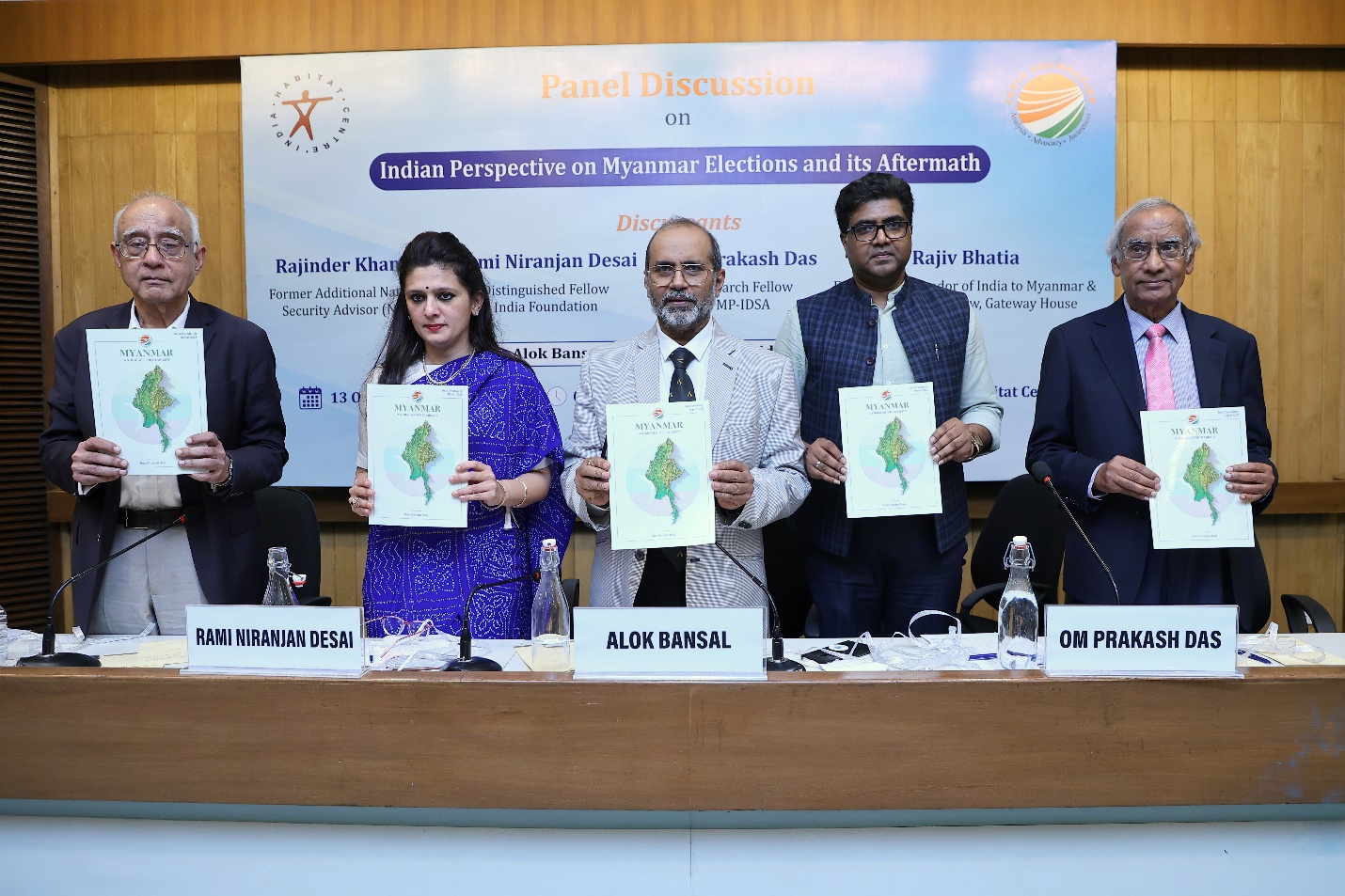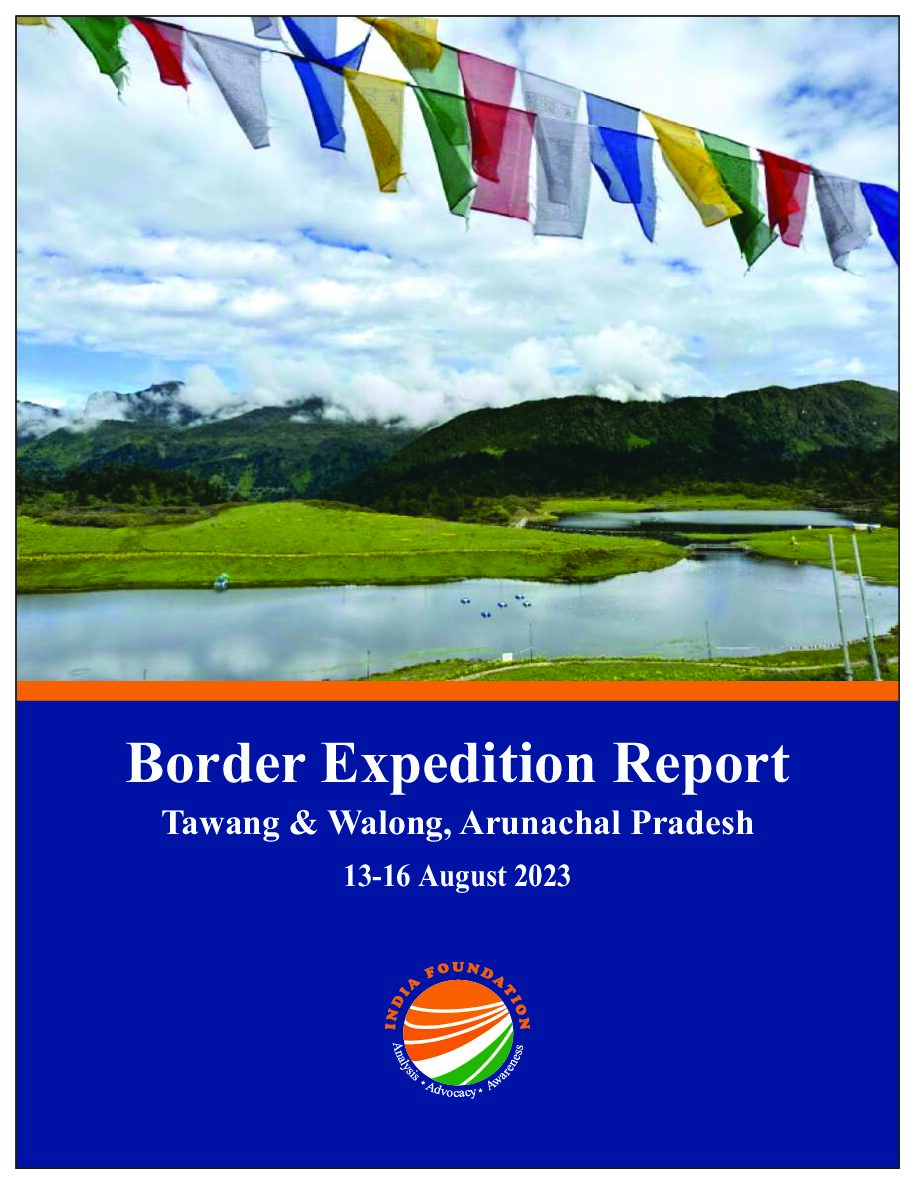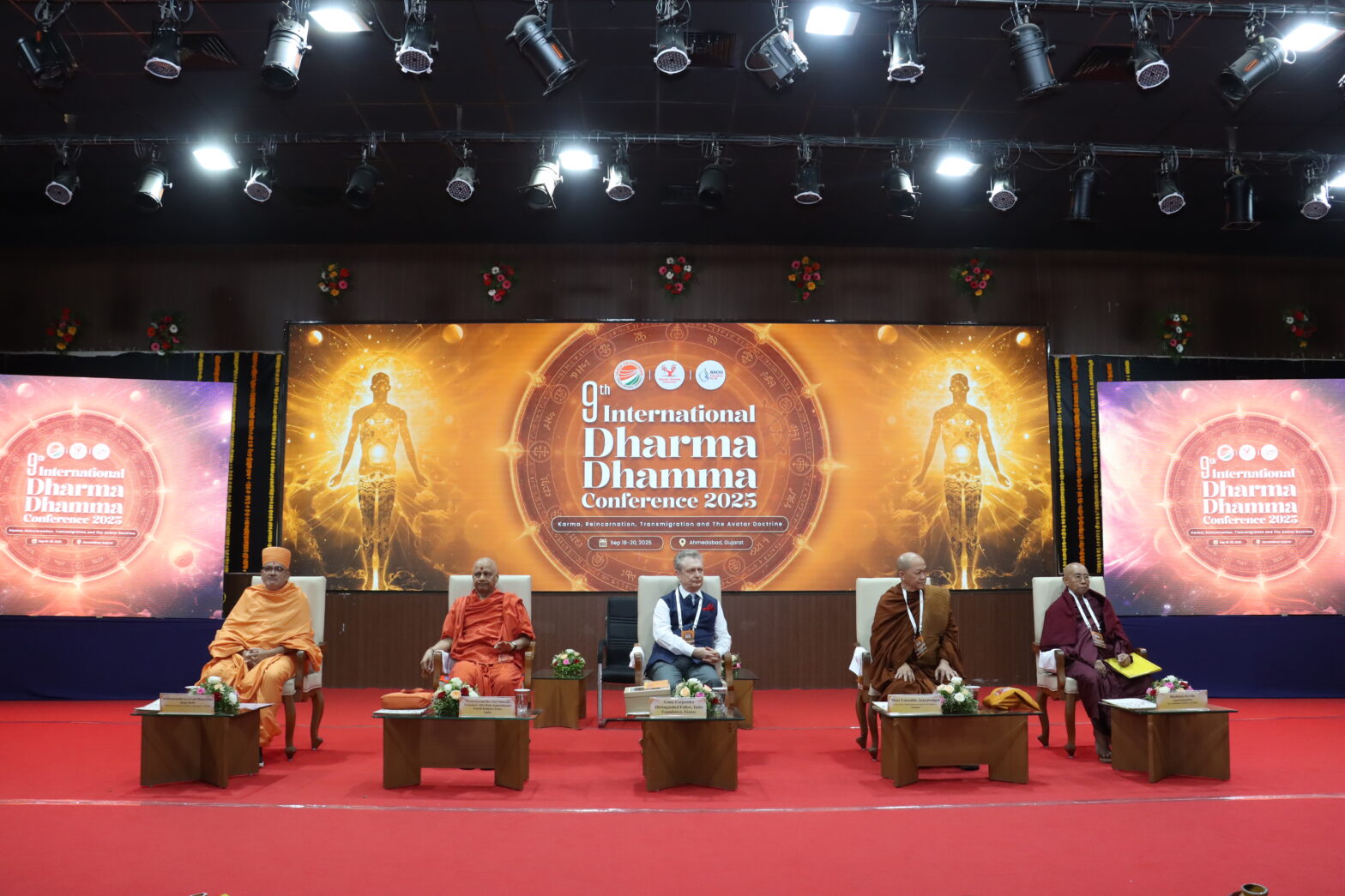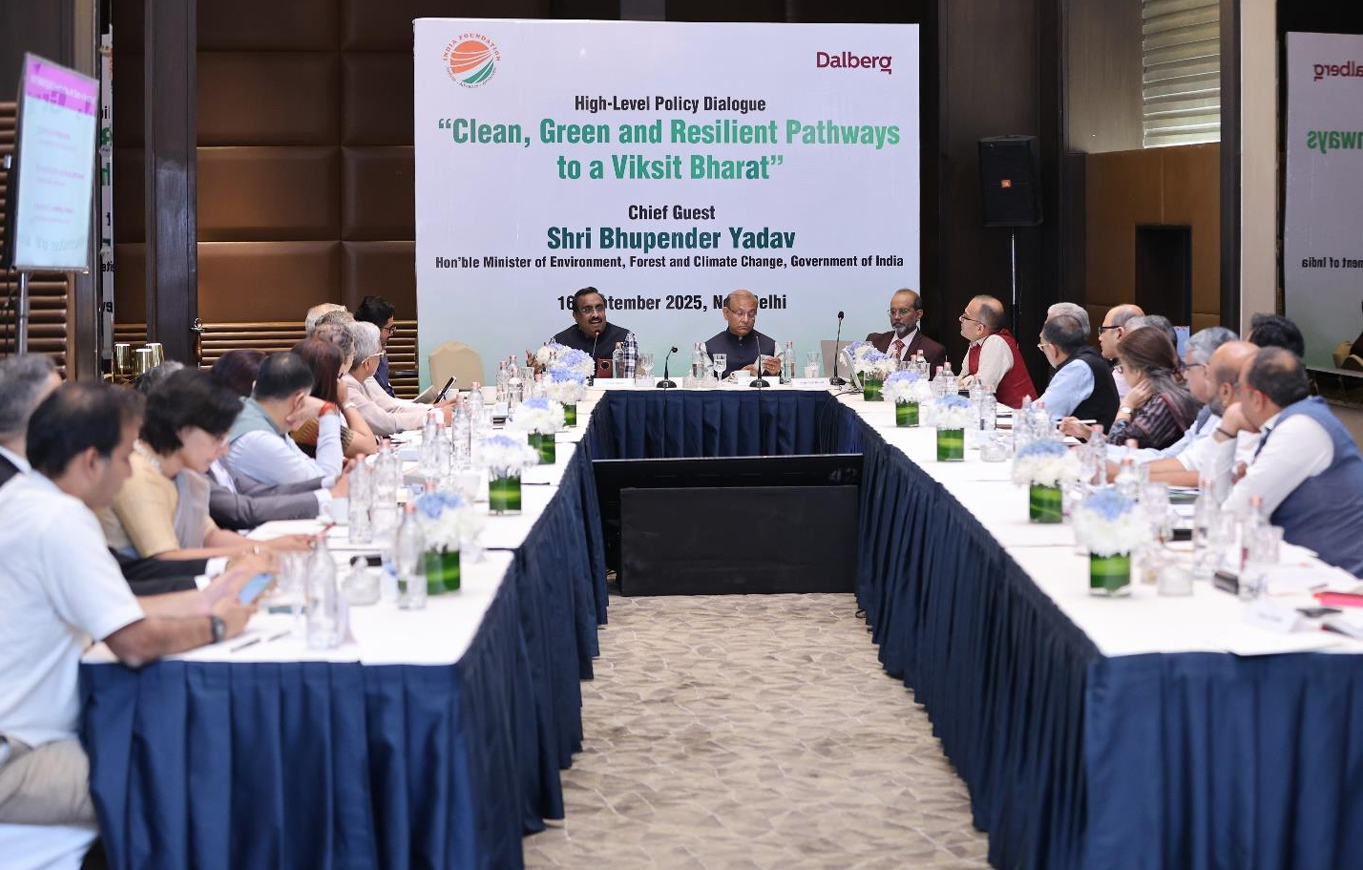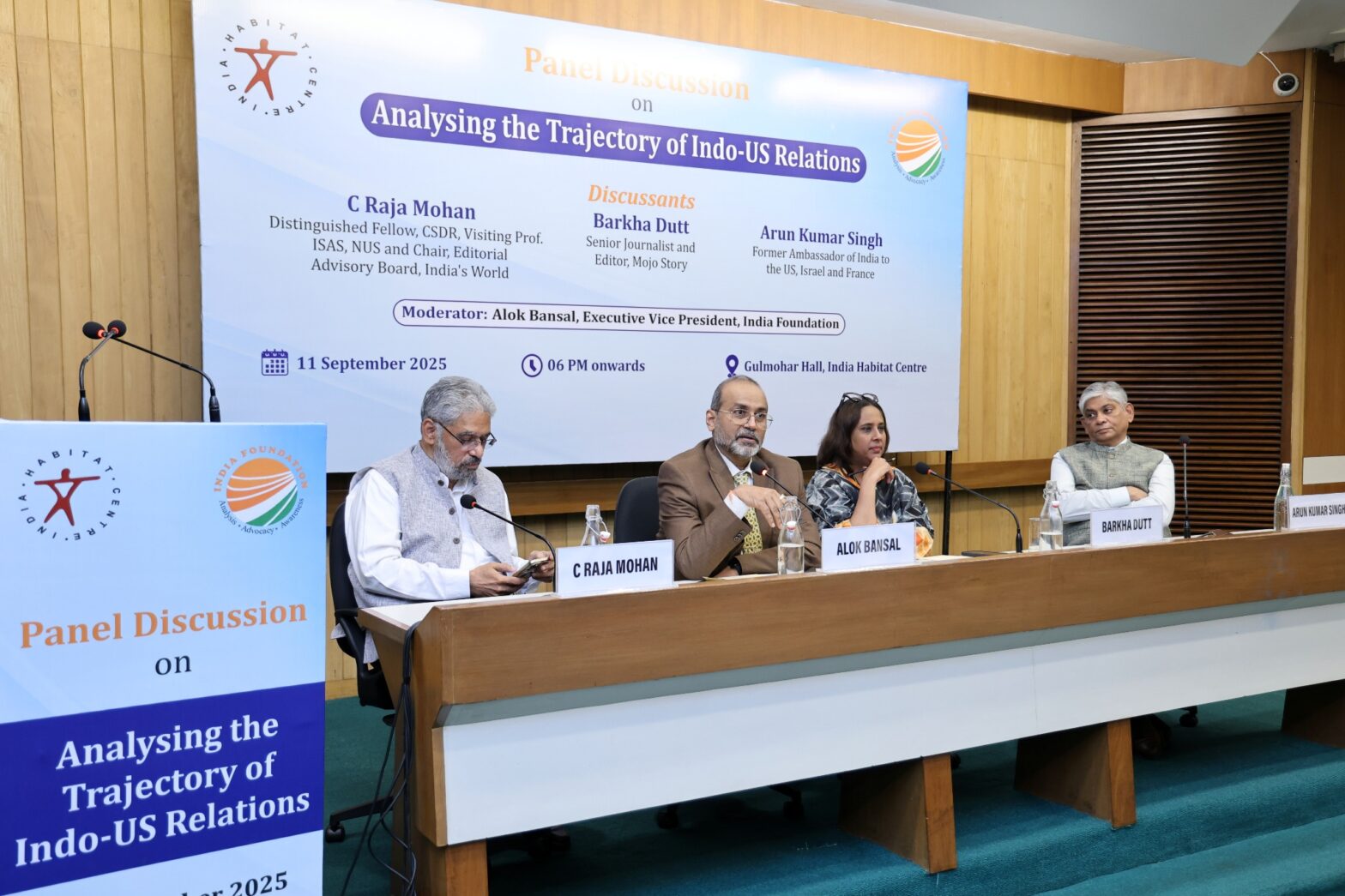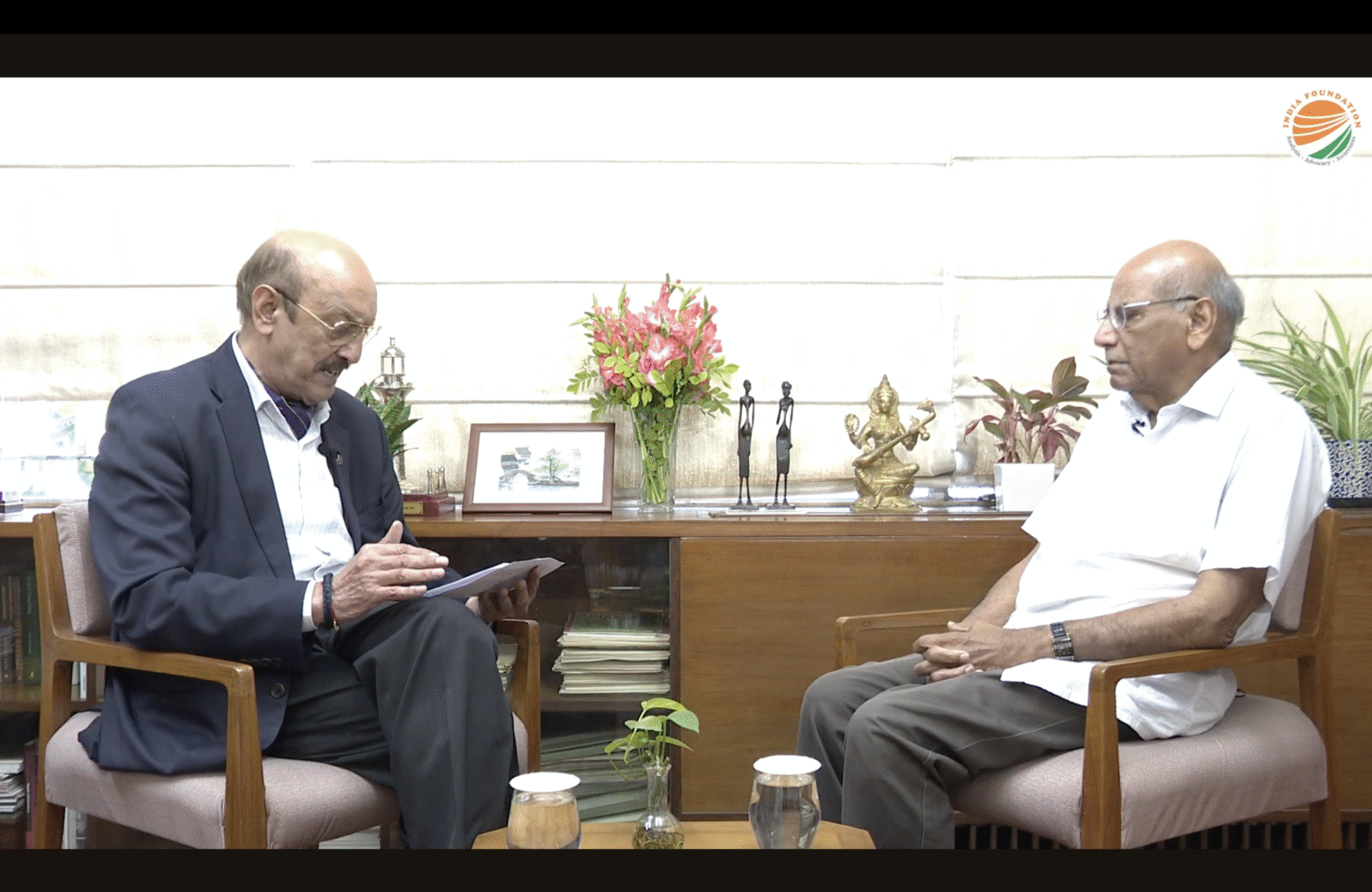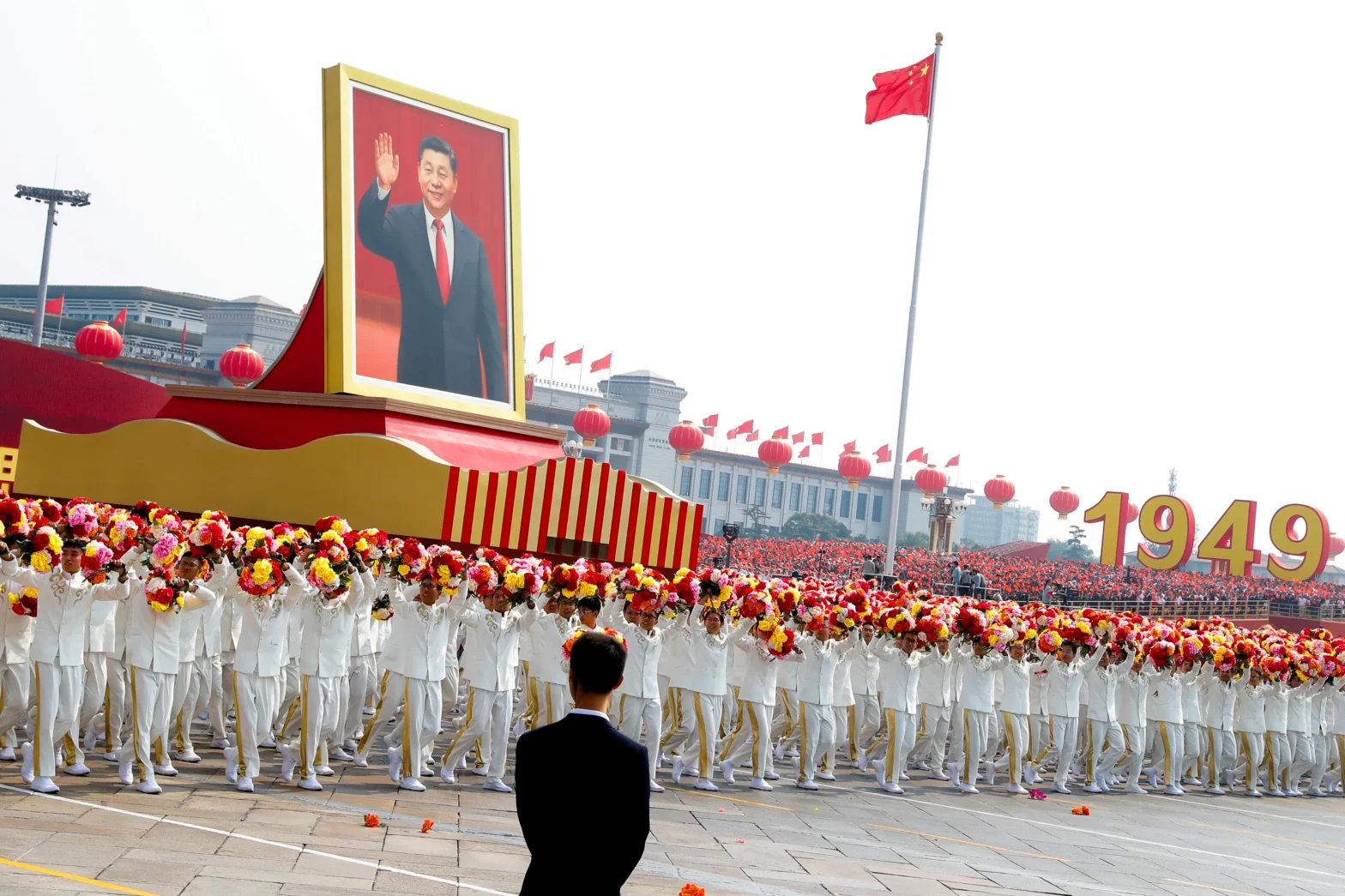IF-IHC Panel Discussion on ‘Indian Perspective on Myanmar Elections and Its Aftermath’
On 13th October 2025, India Foundation in collaboration with India Habitat Centre organised a panel discussion on ‘Indian Perspective on Myanmar Elections and Its Aftermath’. The panel consisted of Shri. Rajinder Khanna, Former Additional National Security Advisor; Ms. Rami Niranjan Desai, Distinguished Fellow, India Foundation; Shri Om Prakash Das, Research Fellow, MP-IDSA; Shri Rajiv Bhatia, Former Ambassador of India to Myanmar and Distinguished Fellow, Gateway House.
The session was moderated by Shri Alok Bansal, Executive Vice President, India Foundation, who in his address highlighted that “elections possess the transformative potential to usher in prospects of peace and development.” He further noted that in today’s interconnected world, media and technology enable a two-way flow of communication, which should form the foundation of constructive engagement and progress in the region. Shri Bansal also observed that Myanmar’s governance and territorial control have long been influenced by various armed organisations, making the country’s political transition particularly complex and multifaceted.
The speakers shared nuanced perspectives on Myanmar’s internal dynamics, the conduct of the elections, and the subsequent political developments. Speakers discussed the continuing influence of the military, the challenges of restoring democratic governance, and humanitarian concerns arising from internal displacement and conflict. The discussion underscored that the situation in Myanmar remains fluid and deeply consequential for the broader South and Southeast Asian region. While the elections were expected to serve as a step towards democratic consolidation, the ensuing political fragmentation has revealed the fragility of the country’s institutions and the entrenched role of the military and armed organisations in governance.
From an Indian perspective, the discussion underscored the delicate balance that the government must maintain- upholding democratic values while safeguarding its strategic and security interests. Experts highlighted the importance of continued engagement with Myanmar’s various stakeholders. Discussants also reflected on the responses of ASEAN and other international actors, analysing the impact of geopolitical competition in the Indo-Pacific on Myanmar’s trajectory. The session reaffirmed that Myanmar’s path to peace and democracy will be long and uncertain, but continued engagements offers the best hope for positive transformation.
Upon completion of the discussion, a report titled ‘Myanmar: A Struggle for Stability,’ based on Ms Rami Niranjan Desai’s expertise and fieldwork, which incorporated visits to different parts of Myanmar was released. Link of the Report:
https://indiafoundation.in/category/report/
Interaction with Executives of VEB.RF | Event Report | October 7, 2025
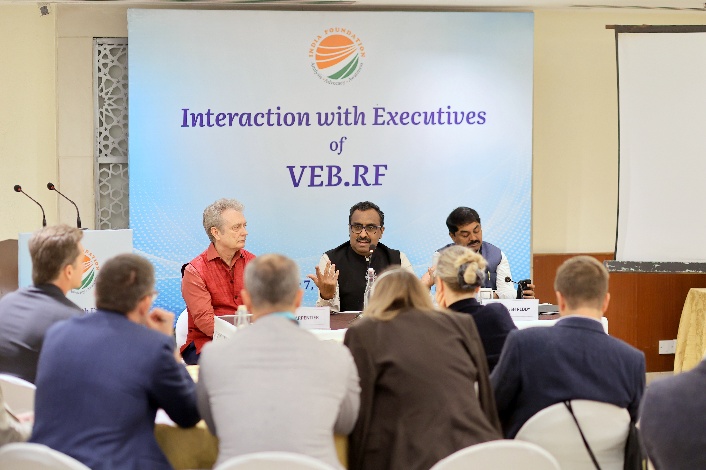
On October 7, 2025, India Foundation organised an interaction with the executives of VEB.RF, a Russian state development corporation and investment company, at Magnolia, India Habitat Centre, New Delhi.
The interaction was chaired by Mr. Côme Carpentier, Distinguished Fellow, India Foundation, and addressed by Dr. Ram Madhav, President, India Foundation, and Dr. G. Satheesh Reddy, Former Chairperson, Defence Research and Development Organisation, and Member, Governing Council, India Foundation.
While welcoming the 35-member delegation to the interaction, Mr. Carpentier underscored the depth of bilateral ties between India and Russia and their importance in the evolving multipolar order. Dr. Madhav, in his address, reiterated the goals of shared growth and prosperity between Russia and India. He underlined the need for India to rise as a strong economy, fulfilling the national priority of becoming a USD10 trillion-economy. Dr. Madhav also directed the delegates’ attention to the need for the empowerment of India’s massive youth population, as well as the steps taken by the government to address it. Describing educational reforms in India, especially the National Education Policy, 2020, he detailed the projects for upskilling the youth and strengthening the tech-driven education in the country.
Speaking of Indo-Russian cooperation in science and technology, he emphasised the strength of India’s information and technology sector and its importance to the Indian economy. He enumerated quantum technology, artificial intelligence, and bio-engineering and genetics as the sectors on which the Indian government is focussing attention. Highlighting the challenges to India’s development story, India’s component dependence for its booming Electronic Vehicle (EV) market on imports is pronounced; developing self-reliance is paramount. Investment in research and development is, as a corollary, expected to catalyse this growth story.
Speaking next, Dr. Reddy spoke of the strategic contours of the bilateral ties between India and Russia. His presentation focussed on the enduring significance of the strategic partnership, along with its evolution from a historically defence-centric relationship into a multifaceted collaboration spanning energy, technology, and innovation. He described how Russia continues to supply a major share of India’s military hardware, with joint ventures in aircraft, tanks, missiles, and naval systems—while new initiatives focus on co-development in drone, radar, AI, and directed-energy technologies. Civil nuclear cooperation remains robust through the Kudankulam project, with future plans for small modular and floating reactors. Economic ties have deepened considerably, with bilateral trade reaching USD 68.7 billion in 2024–25 and a target of USD 100 billion by 2030, supported by new trade routes and diversified exchanges in oil, fertilisers, pharmaceuticals, and steel. He was sanguine about the expansion in scientific and technological collaboration through joint R&D in hyper-sonics, quantum technologies, space, and cyber defence. He mentioned that despite challenges such as sanctions, supply chain delays, and language barriers, the India–Russia relationship is transitioning from a government-to-government model to one emphasizing business partnerships, innovation, and strategic autonomy, positioning both nations to strengthen resilience in a rapidly changing global order.
The session ended with the felicitation of the speakers by representatives of VEB.RF, followed by a noted of thanks by Mr. Carpentier.
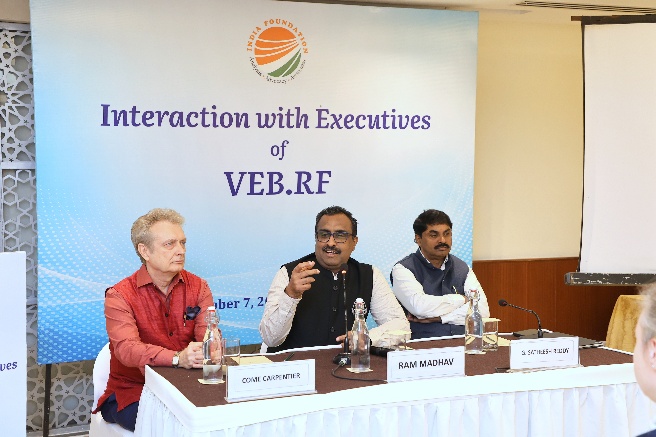
3rd India Foundation Legal Dialogue: Article 142 of the Indian Constitution

The third edition of the India Foundation Legal Dialogue took place on 26 September 2025 at the India Foundation Office, India Habitat Centre, New Delhi. The discussion centred on Article 142 of the Indian Constitution. It featured addresses by Justice Hemant Gupta, former Justice of the Supreme Court of India, and Mr Biswajit Dubey, Additional Advocate General.
The discussion was triggered by a ruling of the Apex Court in which, in exercise of its powers under Article 142 of the Constitution, the Supreme Court, in the case of the State of Tamil Nadu vs Governor of Tamil Nadu 2025, invoked Article 142 to treat 10 bills withheld by the Governor of Tamil Nadu as having received assent. The court found the Governor’s inaction and actions unconstitutional, including reserving the bills for the President a second time after the state legislature had re-passed them. This ruling used the Supreme Court’s power to do “complete justice” and set a precedent for Governors to act on bills within a reasonable timeframe, establishing that they cannot indefinitely delay or block bills after they have been re-passed by the legislature. A time limit was also imposed on the President to decide on the bills reserved for his consideration by the Governor within a period of three months from the date on which such reference is received.
Article 142 grants the Supreme Court powers to deliver complete justice. In light of the Supreme Court’s decision, there has been significant public and legal scrutiny of the judgment. The legal intricacies of this decision were examined alongside its more constitutional repercussions. The interaction of the Court’s exercise of these extraordinary powers with Articles 141, 200, 201, and 361 of the Constitution was also discussed.
It was observed that Article 142 has long held a special status within India’s constitutional framework. Unlike Article 141, which codified the binding nature of the declarations of law made by the Supreme Court, Article 142 grants the Court the authority to pass such a decree or make such an order as it deems necessary to achieve complete justice in any cause or matter before it. The framers designed this broad, open-ended phrase to give the Supreme Court an unprecedented constitutional tool for addressing situations in which strict interpretation of statutory law may not yield a just outcome. Over time, the Court has applied Article 142 in various contexts: family law, criminal justice, service issues, and most recently, high-stakes constitutional cases involving relations between the state and other entities.
During the discussion, it was observed that the recent Tamil Nadu case marked a pivotal moment in the modern constitutional history of Article 142. The Governor had refused to approve several bills passed by the state legislature, repeatedly delaying their approval, and some had been reintroduced after being returned. Subsequently, some bills were bypassed by the President without following the constitutional process. This led to a constitutional deadlock that persisted for a significant period, effectively hindering the functioning of both the state legislature and the executive. The Supreme Court intervened and declared that the reservation of ten bills for the President’s assent by the Governor was “illegal and liable to be set aside”. The exercise of judicial power has been widely debated since the Court ventured into an area traditionally considered a constitutional domain of the Governor and the President.
The differences between Articles 141 and 142, both in writing and in application, were discussed in detail. The fact that Article 141 serves as the Court’s law-declaring function was emphasised. When the Supreme Court interprets the Constitution or a statute, its pronouncements are in rem and binding on all courts and powers throughout the country. This ensures consistency and predictability in the law. Conversely, Article 142 is not a law-declaring provision. It grants the Court authority to shape relief between the parties and administer it within the case to achieve complete justice. Orders made under Article 142 are inter partes binding but do not necessarily serve as precedent. The two provisions occupy distinct yet complementary constitutional roles. Article 141 provides the overarching legal framework, while Article 142 serves as a judicial safety valve—a tool for exceptional cases where the existing law may not deliver fair outcomes.
This distinction was discussed through landmark judgments of the court. In Supreme Court Bar Association v. Union of India, 1998, it was stated that Article 142 may not be invoked to replace substantive law in a way that produces impermissible effects. A Constitution Bench held that the Court’s powers under Article 142 are supplementary and must operate within the constitutional framework. In P. Ramachandra Rao v. State of Karnataka, 2002, a case decided by a seven-judge bench, it was reaffirmed that under Article 142, they could not create legislation by imposing time limits on criminal proceedings, as these rightly form part of the legislative process. These cases reflect the consistent judicial stance: Article 142 is a powerful tool, but it does not authorise the making of laws.
The range of cases in which Article 142 has been applicable throughout history was also discussed. The Supreme Court has frequently invoked Article 142 to annul marriages before the standard time period to facilitate reconciliation, ensuring that ongoing and contentious cases are resolved. Article 142 has been drafted to provide relief in extraordinary circumstances involving service and labour issues. A notable case is State of Punjab & Others vs Rafiq Masih (White Washer) 2014, where the Court relied on Article 142 to prevent employees from being deprived of fair recovery of excess salary payments made in good faith. Additionally, Article 142 has been utilised in criminal law remission cases involving administrative or constitutional inaction. In the case of A.G. Perarivalan v. State of Tamil Nadu 2022, despite no change to the legal framework for remission, the individual petitioner was granted justice through forward remission recommendations, relying on Article 142.
In this jurisprudential context, the Tamil Nadu case was examined in detail. Paragraphs 432 and 433 of the judgment were referenced in the discussion, in which the Supreme Court explained its ruling, stating that assent had been granted under Article 142. As noted, the Court’s reasoning was cautious and deliberate. The Court concluded that the Governor committed clear constitutional violations, since the Governor’s assent alone was the only action permitted by the Constitution. The Court invoked Article 142 to resolve the persistent legislative deadlock. Notably, the Court clarified that its order was not intended to establish a general rule for all similar future cases, but applied solely to the specific situation in which it was issued. The participants affirmed that this was a prudent application of Article 142—a measure necessary to uphold constitutional governance and judicial restraint.
Much was discussed about the effects of this decision on the federal structure and the separation of powers. Participants noted that the flexibility of Article 142 enables the judiciary to act effectively when constitutional actors are unable to perform their duties, thereby preventing constitutional paralysis. Others cautioned that the broad application of Article 142 might lead to confusion between judicial roles and those of the executive or the legislature, raising concerns of overreach. It was emphasised that the legitimacy of powers granted by Article 142 largely depends on the Court’s precise definition of its limits and the exceptional nature of the circumstances.
The discussion also covered the placement of Articles 141 and 142 within the Constitution. The placement of Article 142 after Article 141 was deemed significant. This sequence shows that Article 142 does not alter the law established by Article 141; instead, it acts as a supplement. It does not replace but fills the gaps left by broader legal rules. Jurisprudence from the Supreme Court Bar Association and the P. Ramachandra Rao cases was cited to support this view. Article 142 operates within the overall constitutional framework and must be used in accordance with public policy, federal principles, and the doctrine of basic structure.

They then proceeded to consider the pending constitutional issues left to be decided by the Supreme Court under Article 143. These include whether the Governors and Presidents may have timelines imposed on them by the courts, whether actions taken before assent by a Governor can be subject to judicial review, and whether Article 142 could be used as a substitute for constitutionally assigned roles of Governors and Presidents. It was noted that the Court’s future advisory opinion on such questions would likely define the boundaries of Article 142’s use in federal disputes for many years to come. Although limited to factual circumstances, the Tamil Nadu judgment has successfully initiated a more inclusive constitutional discussion on the extent of judiciary intervention versus constitutional functional autonomy.
During the debate, participants emphasised the importance of judicial self-restraint. Article 142 is a unique constitutional mechanism — it grants the Supreme Court the authority to administer justice in challenging cases, but it does not mean unrestricted power. It is only legitimate when applied cautiously and sparingly. When used appropriately, Article 142 allows the Court to serve as a constitutional check-and-balance, intervening to prevent failures in governance or injustice in extraordinary circumstances. However, if overused, it could threaten the stability of the three branches of government. Additionally, it was noted that courts have procedural timelines—such as those described as “shall” or “may complete”—which are not always strictly followed, making case applications dependent on specific circumstances, much like other constitutional functionaries.
After an extensive discussion, the roundtable identified several issues. To begin with, Article 142 and Article 141 should be properly distinguished both theoretically and practically. The former is case-specific and may act between the parties, whereas the latter is law-declaring and may act in rem. Second, Article 142 is an additional power to act within constitutional limits and is guided by precedent and social policy. Third, although Article 142 may be important in resolving extraordinary constitutional stalemates, as in the case of Tamil Nadu, its application should be limited to such situations. Lastly, the impending presidential referendum is likely to shed much-needed light on how Article 142 may be applied concerning authority, timeframes, and the judicial replacement of constitutional roles.
The Tamil Nadu ruling has thus become a reference point in examining the role of Article 142 in the Constitution of India. It illustrates the potential and limits of judicial authority in upholding constitutional governance. As discussed, Article 142 is not a legislative instrument or a constitutional override. It is a provision designed to prevent justice from being bypassed through procedural gaps, administrative negligence, or exceptional circumstances. It is not only about the scope of its powers but also about the discipline with which it is exercised.

The sixth session of “Katha: The Folklore Circle”
The sixth session of “Katha: The Folklore Circle” was held on 25 September 2025, titled “Cosmic Dance of Sun and Moon: Stories for Equinox”. The evening celebrated the celestial interplay of Sun and Moon, exploring narratives of balance, time and cosmic rhythm across cultures.
Our Master Storyteller was Mr. Nitten Nair, Founder of Mythlok. Drawing on his deep engagement with mythology and narrative traditions, Mr. Nair brought each story to life with vivid imagery, expressive pacing and a nuanced understanding of cultural context. His narration guided the audience through the ways different civilizations have imagined the movement and relationship of the Sun and Moon, connecting celestial patterns to human imagination and values.
The session featured stories including Malina and Igaluk from Inuit mythology, Tsukuyomi and Amaterasu from Japanese mythology, Mayari and Apolaki from Philippine mythology, and Surya and Chandra from Indian mythology. Each tale highlighted themes of harmony, duality, and the eternal interplay between light and darkness.
Attendees were actively engaged, reflecting on the universal symbolism of the Sun and Moon, and drawing parallels with contemporary life, cultural practices, and personal rhythms. The discussion emphasised how myths encode human understanding of time, balance and cosmic order. By the end of the evening, participants left with a renewed sense of connection to global mythologies and the cosmic patterns that shape human imagination, reinforcing Katha’s mission to bridge cultures through storytelling and to invite reflection on timeless narratives.


IF-IHC Book Discussion on ‘Trial by Water: Indus Basin and India-Pakistan Relations’, by Shri Uttam Kumar Sinha
India Foundation, in collaboration with the India Habitat Centre, organised a book discussion on the book ‘Trial by Water: Indus Basin and India-Pakistan Relations’, by Shri Uttam Kumar Sinha, Author and Scholar, on Monday, September 22, 2025, at India Habitat Centre. Dr. DV Thareja, Former Indus Water Commissioner and Former Member (D&R), CWC; Dr. Tara Kartha, Director (R&A), CLAWS; and Amb. Sharath Sabharwal, Former High Commissioner of India to Pakistan, discussed the book with the author. The session was moderated by Capt. Alok Bansal, Executive Vice President, India Foundation.
Shri Uttam Kumar Sinha clarified that the treaty was not solely about water sharing but involved a complex division of river systems, with an 80/20 water allocation split, often perceived as unfair by both nations. He addressed misconceptions about the treaty, emphasizing Nehru’s intent to foster peace, contrasted by opposing motivations from other stakeholders. Shri Sinha noted the pivotal role of engineers, like Gopi Chandra Bhagawan, who resisted concessions to Pakistan, and the influence of U.S. soft power through funding and engineering expertise under “Water for Development.” He stressed the importance of precise wording, advocating for terms like “water development for Kashmiris” over “stoppage,” and clarified that the book focuses on India’s perspective, with one chapter addressing Pakistan’s propaganda.
The panelists provided diverse insights. Dr. DV Thareja described the book as personally resonant, aligning with his experiences overseeing related projects, and highlighted global dam-building trends, particularly China’s 6,000 dams. Dr. Tara Kartha refuted Pakistan’s claims of water shortages, citing IRSA data, and discussed recent floods causing significant damage in Punjab and the depletion of glaciers, noting Pakistan’s upper riparian advantage on the Kabul River. Amb. Sharath Sabharwal praised the book’s accessibility and research, emphasizing the treaty’s lack of resilience, its controversial nature, and the need to understand the Indus Basin’s history to address future challenges, amid emotive public debates and mistrust in India-Pakistan relations. The discussion underscored the intricate interplay of water, geopolitics, and diplomacy in the Indus Basin. The event highlighted the treaty’s engineering-driven origins, its ongoing challenges, and the emotional complexities encapsulated in the sentiment that “blood and water cannot flow together.”
Border Expedition Report
9th International Dharma Dhamma Conference, Ahmedabad, 18–20 September 2025
The 9th International Dharma-Dhamma Conference, jointly organised by India Foundation and Dr. Babasaheb Ambedkar Open University, Ahmedabad, was inaugurated on 18 September 2025 at the University campus. With the theme “Karma, Reincarnation, Transmigration, and the Avatar Doctrine”, the three-day conference brought together over 200 scholars, spiritual leaders, and policymakers from sixteen countries that includes Armenia, Bhutan, Cambodia, Canada, France, Georgia, India, Japan, Mauritius, Myanmar, Nepal, Singapore, South Korea, Sri Lanka, Thailand and Vietnam. The conference reaffirmed its position as a premier global platform for dialogue between Hindu and Buddhist traditions, aimed at fostering harmony, interconnectedness, and a shared philosophical framework for the emerging world order.
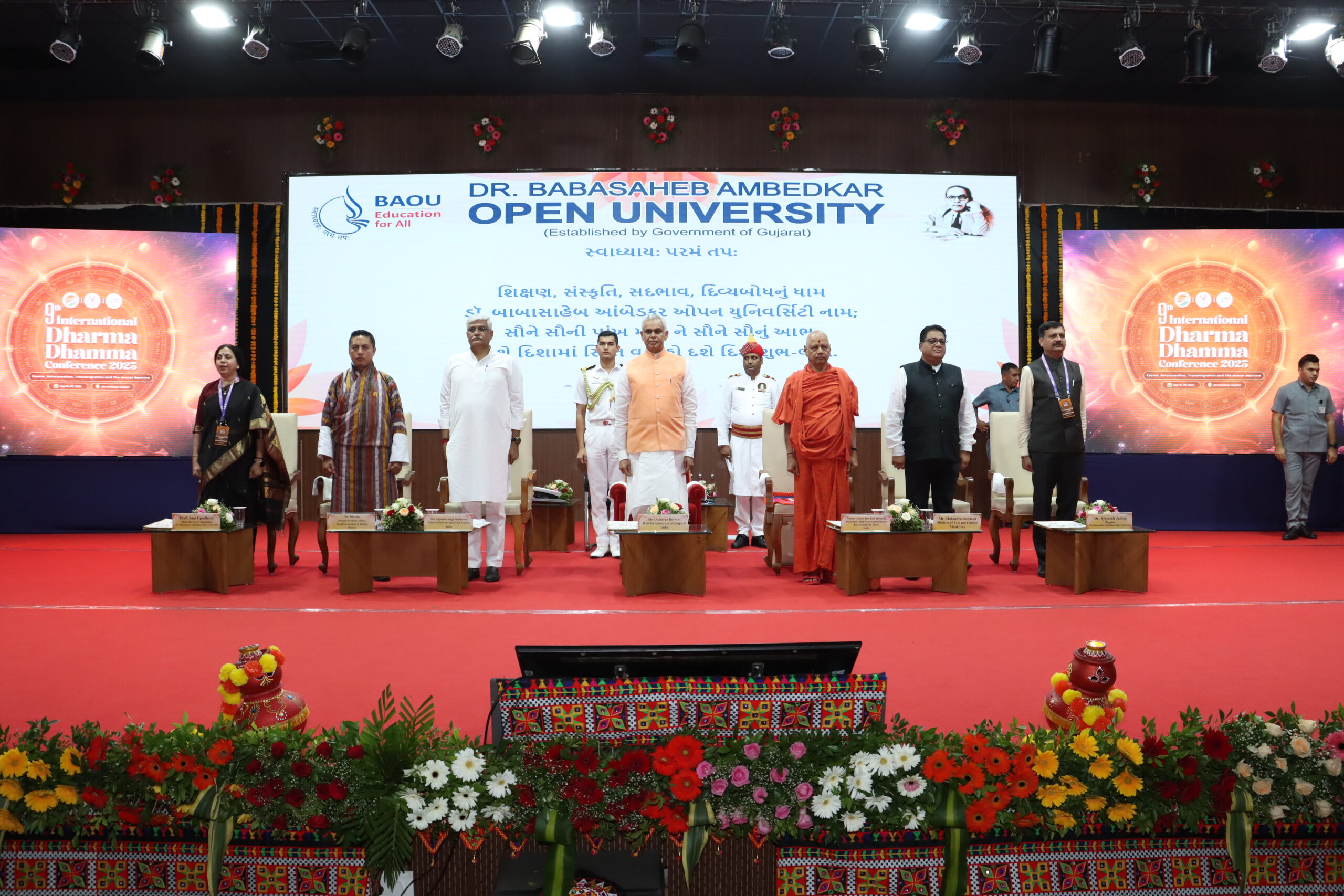
The inaugural session was graced by eminent dignitaries including Shri Acharya Devvrat, Hon’ble Governor of Gujarat; Shri Gajendra Singh Shekhawat, Hon’ble Union Minister of Culture and Tourism, Government of India; H.E. Mahendra Gondeea, OSK, Minister of Arts and Culture, Mauritius; H.E. Tshering, Minister of Home Affairs, Royal Government of Bhutan; Swami Govinda Dev Giri Ji Maharaj, Treasurer, Shri Ram Janmabhoomi Teerth Kshetra Trust and Prof. Dr. Ami Upadhyay, Vice Chancellor, Dr. Babasaheb Ambedkar Open University.
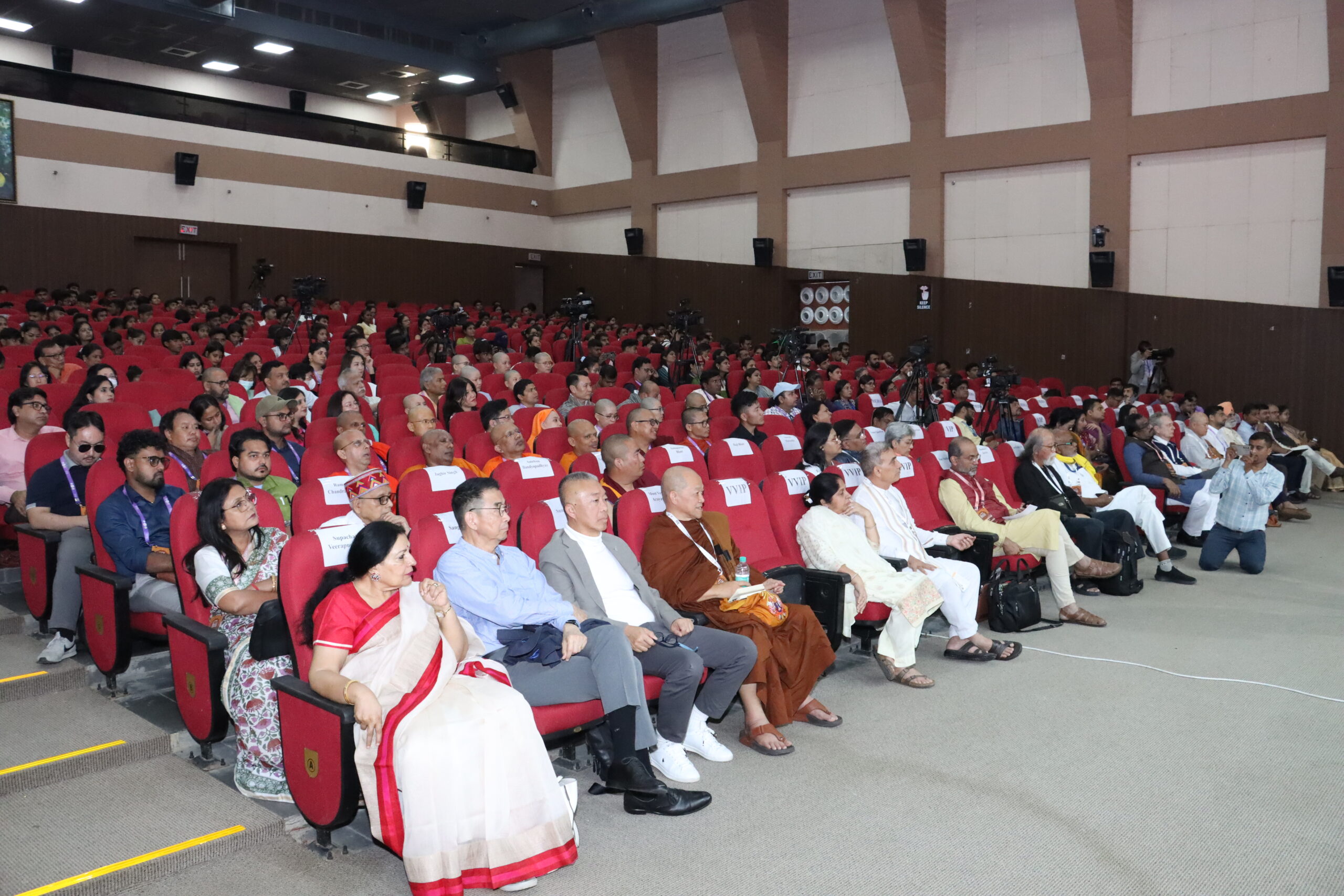
Over the course of three days, a total of 91 research papers were presented across 15 parallel sessions, constituting a significant part of the 9th International Dharma Dhamma Conference. Jointly convened by India Foundation and Dr. Babasaheb Ambedkar Open University, Ahmedabad, Gujarat, this segment provided a rigorous academic platform for scholars, researchers, and practitioners to share innovative perspectives on the overarching theme “Karma, Reincarnation, Transmigration and The Avatar Doctrine.”
Inaugural Session:
The inaugural session of the 9th International Dharma-Dhamma Conference began with an inspiring address by Swami Govinda Dev Giri Ji Maharaj, Treasurer, Shri Ram Janmabhoomi Teerth Kshetra Trust. Welcoming the gathering on behalf of India Foundation and as the Chair of the organising committee of the 9th DDC 2025, he spoke of India as the cradle of spiritual traditions including Hinduism, Buddhism, and Jainism. Emphasizing that the foundation of Indian thought is Dharma, he noted, “Our ancestors have taught us non-aggression and moral elevation, with the eternal motto: Sarve Bhavantu Sukhinah — may all be happy. Differences may exist here and there, but the sameness of our values is far greater.” He urged participants to strengthen the ties of brotherhood, focus on unity rather than differences, and collectively face the challenges confronting humanity.
H.E. Tshering, Minister of Home Affairs, Royal Government of Bhutan, extended warm appreciation to the hosts for convening the timely dialogue. He reflected on the need to reaffirm Dharma in a world dominated by materialism and secular thought: “Dharma is the timeless source of peace, harmony, and happiness. Both Hinduism and Buddhism remind us that life is interconnected, that we are bound together in a shared destiny.” He explained how the Buddhist principle of pratītyasamutpāda (dependent origination) underscores this interdependence, linking karma, reincarnation, and transmigration to a shared reality of existence. Citing contemporary challenges like climate change, inequality, and polarization, he stressed the urgent need for compassion and collective action. Concluding, he invited delegates to Bhutan’s forthcoming Global Peace Prayer Festival in November 2025, framing it as a continuation of the eternal cycle of Dharma.
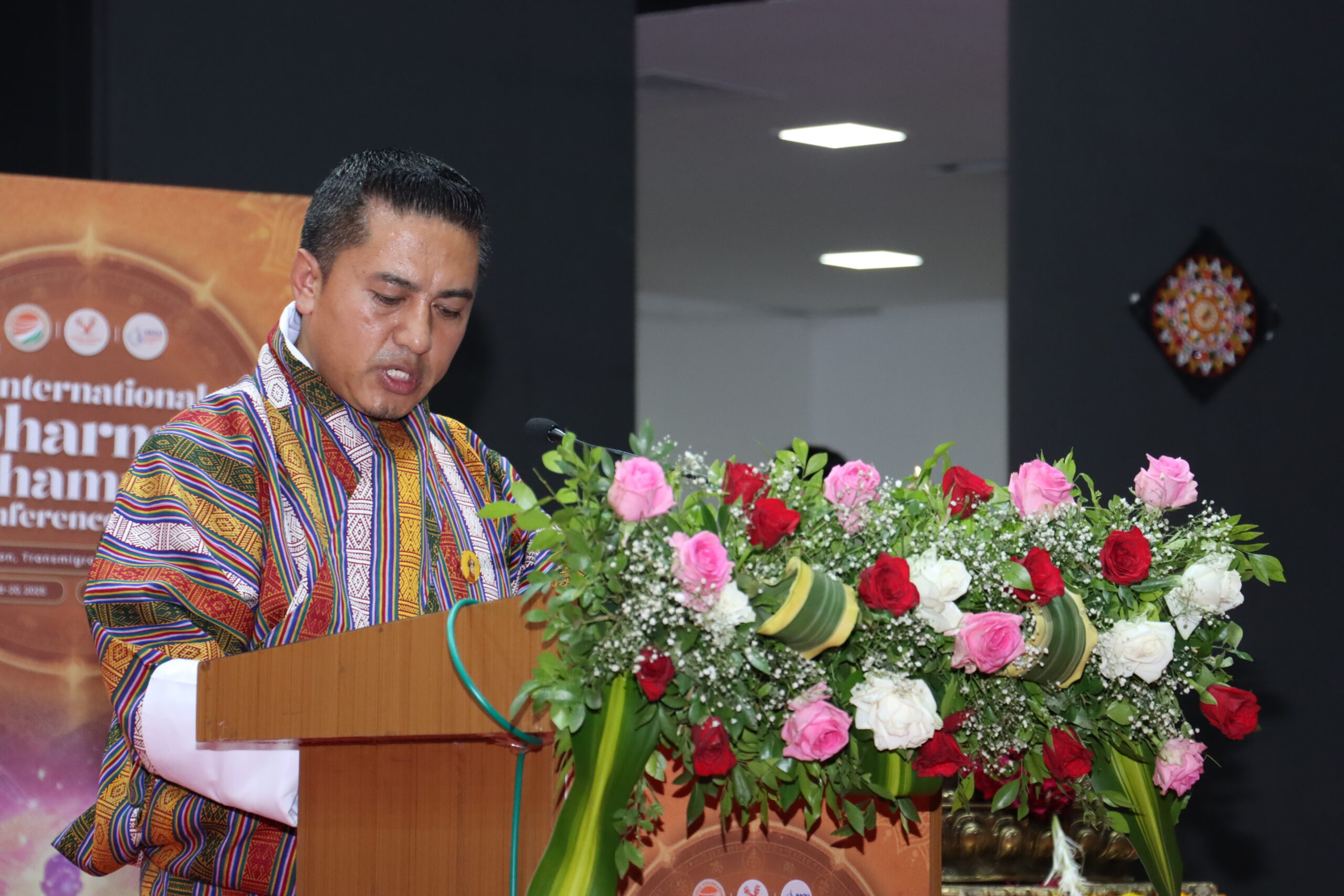
From Mauritius, H.E. Mahendra Gondeea, OSK, Minister of Arts and Culture, situated his country’s cultural experience within the spirit of Dharma. He remarked, “Mauritius is a living testament to the enduring relevance of Dharma in the modern world. Our multicultural society thrives on tolerance, dialogue, and respect — values deeply rooted in Dharma traditions.” Drawing on the conference theme, he underlined how karma and reincarnation can serve as guiding principles for reconciliation, non-violent diplomacy, and environmental responsibility. He noted that peace is not simply the absence of conflict but the presence of justice and shared prosperity. Recalling the words of Mahatma Gandhi — “The best way to find yourself is to lose yourself in the service of others” — he urged the gathering to build a new world order anchored in Dharma, compassion, and sustainability.

Delivering his address, Shri Gajendra Singh Shekhawat, Hon’ble Union Minister of Culture and Tourism, Government of India, posed profound questions on human existence, noting that civilizations flourish not by power alone but by their capacity to engage with philosophy and truth. He clarified that karma is not fatalistic destiny but the architecture of responsibility, while reincarnation teaches humility and interconnectedness. Highlighting the avatar doctrine, he explained, “When Dharma declines, the moral order renews itself through reformers, saints, and great movements. This doctrine is not just about divine descent, but about hope — a reminder that compassion reappears when the world needs it most.” He called for the application of ancient wisdom to modern challenges, from climate change to cultural diplomacy, and reaffirmed India’s commitment to preserving and sharing its spiritual heritage globally.
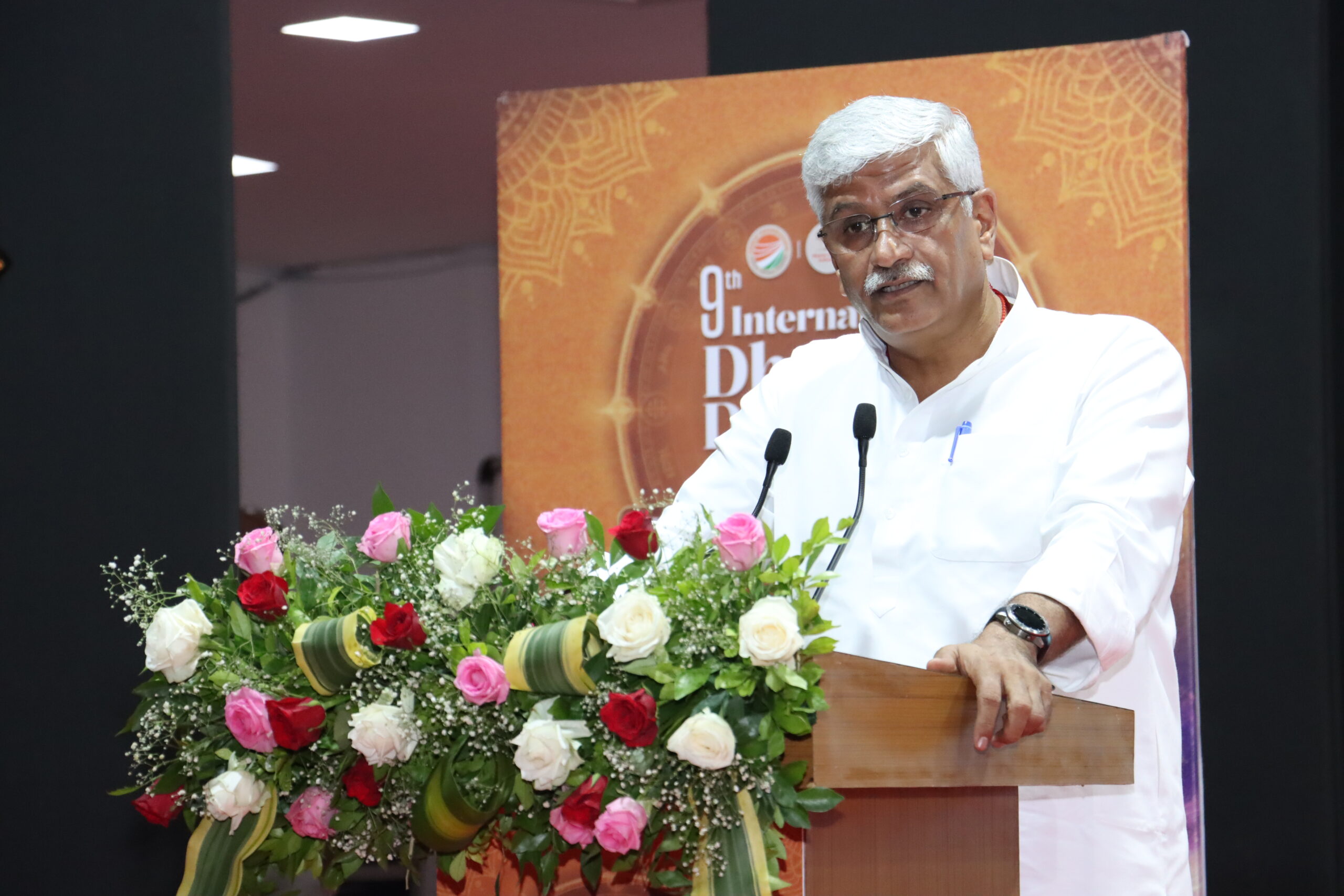
Shri Acharya Devvrat, Hon’ble Governor of Gujarat, in his address congratulated the organizers and emphasized that philosophy defines the true purpose of life. He highlighted the Vedas as the world’s oldest repository of knowledge and recalled the eternal dictum Dharmo Rakṣati Rakṣitaḥ, noting that Dharma alone sustains the balance between violence and non-violence, Dharma and Adharma, and guides humanity toward righteousness. Invoking Maharshi Dayanand Saraswati, he underlined the importance of the doctrine of rebirth in understanding the continuity of life and Dharma. He stressed that Dharma was created to guide human conduct in every aspect of life and explained that practical living according to Dharma means not lying if we do not want others to lie to us and not looking at another’s sister or daughter with ill intent if we expect the same for our own. He further noted that the opposite of non-violence is violence, and the opposite of truth is falsehood; when these are applied to society, whatever sustains it is Dharma, and what fails to do so is Adharma, asking rhetorically whether society could survive even a single day on falsehood.
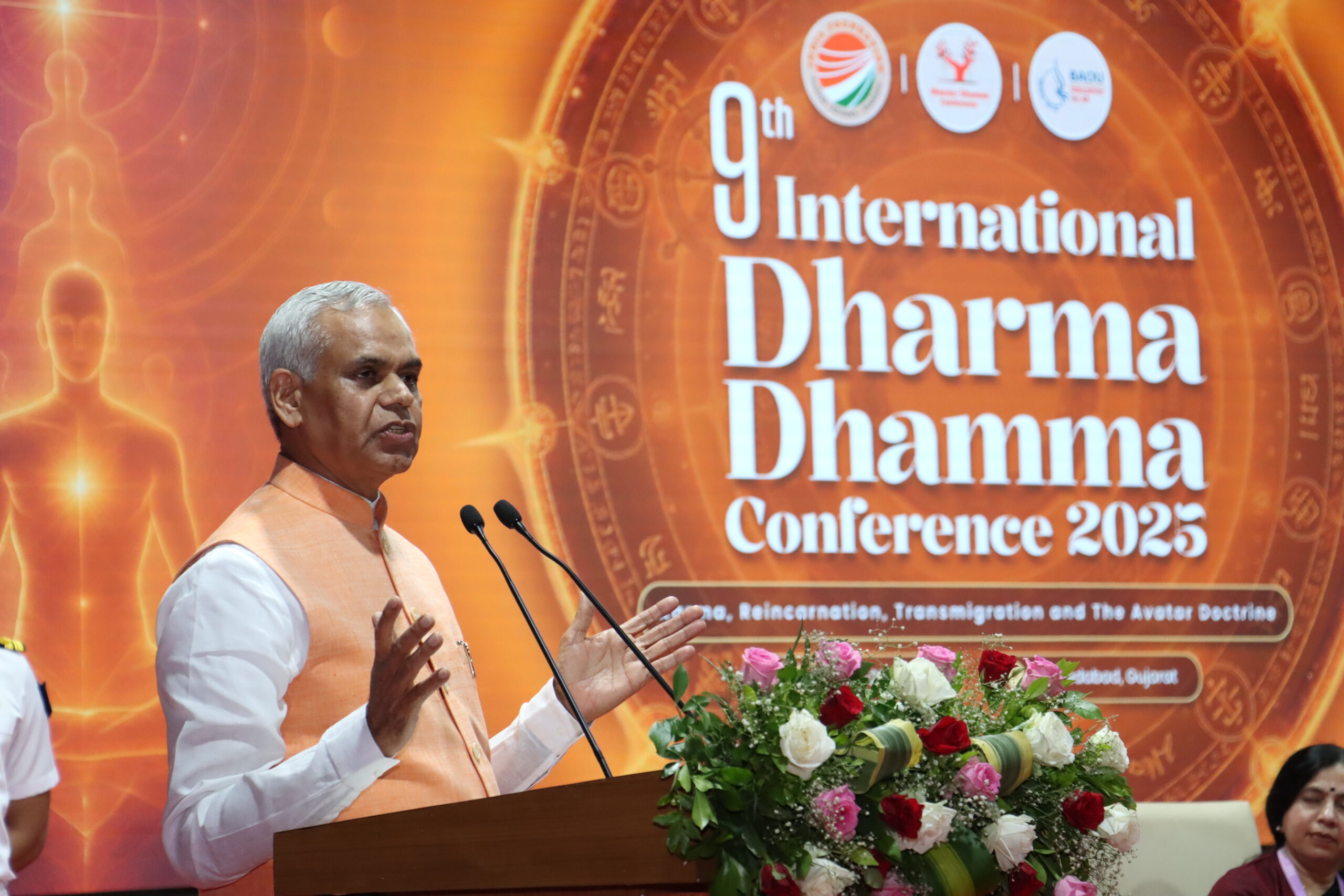
Benedictory Session:
The benedictory session of the 9th International Dharma Dhamma Conference was chaired by Mr. Come Carpentier, Distinguished Fellow, India Foundation and Co-Chair of the 9th DDC 2025, who opened the dialogue with profound reflections on the eternity of the universe. Drawing parallels with the Kalpavriksha and the Bodhi Tree, he reminded the audience that the law of karma remains central to the functioning of existence. He noted that even modern scientific explorations, including quantum physics, continue to echo these timeless insights, reaffirming how ancient wisdom remains aligned with contemporary understanding of the cosmos.
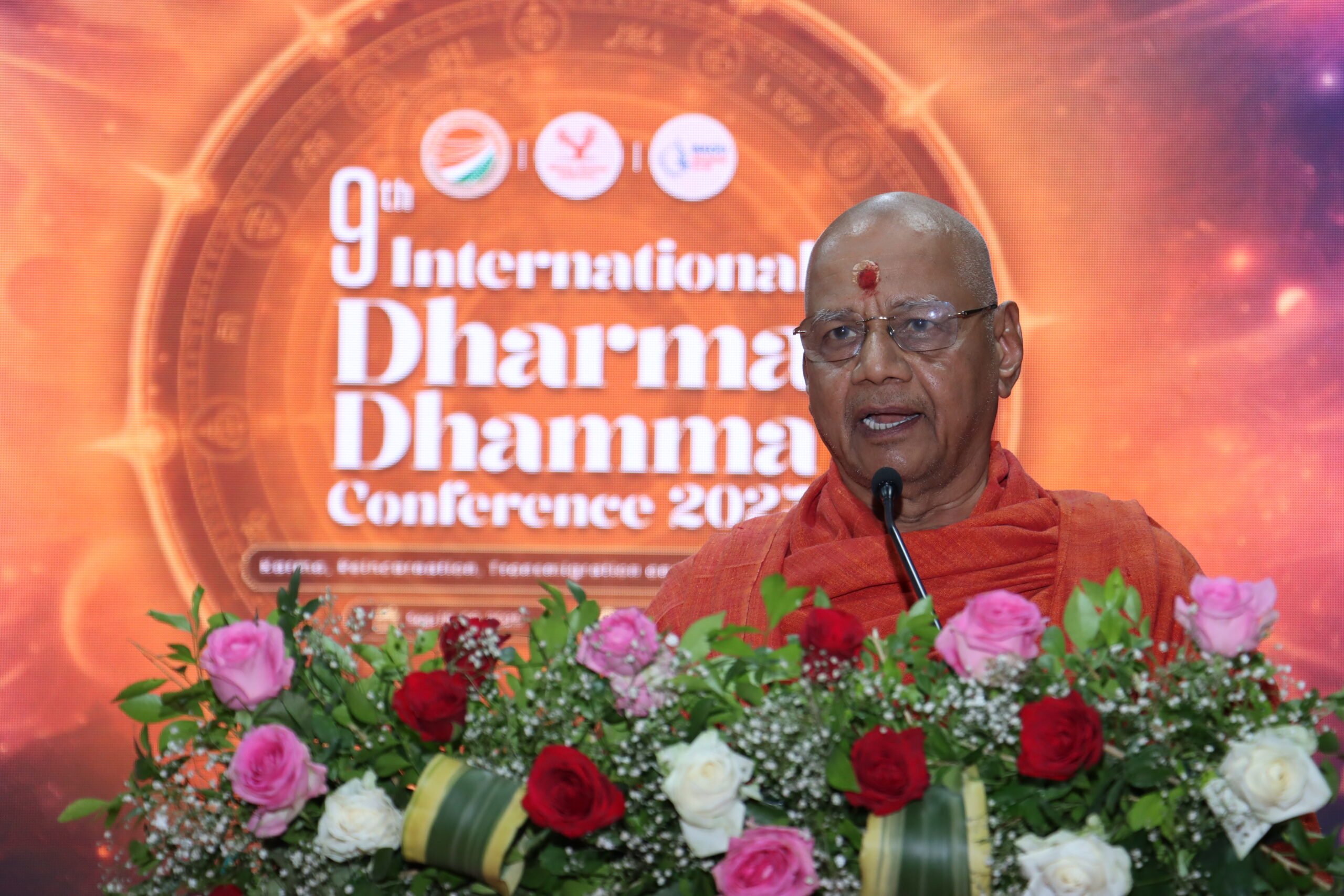
Swami Govinda Dev Giri Ji Maharaj, Treasurer, Shri Ram Janmabhoomi Teerth Kshetra Trust, India, reflected on karma as noble action that underpins life across Vedic, Jain, and Buddhist traditions. He explained the Vedic classification of karma and stressed the need for balance in life, quoting the prayer “Asato Ma Sadgamaya, Tamaso Ma Jyotirgamaya.” Speaking on the doctrine of avatars, he emphasized that incarnations arise whenever moral equilibrium falters, with their purpose being the restoration of righteousness and harmony in society.
From Thailand, Most Venerable Arayawangso, Chief Abbot of Buddhapojhariphunchai Forest Monastery (D) under Royal Patronage of HRH Princess Bajrakitiyabha Narendira Debyavati, the Princess Rajasarini Siribajra Mahavajrarajadhita, spoke of Dhamma as natural law, encompassing the laws of action, biology, and physics. Drawing from Buddha’s enlightenment, he explained central Buddhist concepts such as mano kamma (mental action), idapaccayata(conditionality), and paticcasamuppada (dependent origination), highlighting the interconnectedness of existence. Reaffirming the Four Noble Truths, he underscored the enduring relevance of Dhamma as the guiding principle of wisdom and liberation.
Mahamahopadhyaya Swami Bhadreshdas, Head, BAPS Swaminarayan Research Institute, Akshardham, New Delhi, described the conference theme as addressing the mystery of the entire universe. He emphasized that the pursuit of moksha illustrates the depth of Indian philosophical thought. Reflecting on the eternal struggle between dharma and adharma and the varied types of karma, he stressed that sincere fulfillment of one’s kartavya (duty) leaves an enduring legacy. Citing the story of Nachiketa and principles of the Bhagavad Gita, he affirmed that righteous action and spirituality form the bedrock of Dharma’s continuity.

Concluding the Benedictory session, Bhaddanta Kovida, Aggamahapandita, Aggamahasaddhammajotikadhaja, Vice Chairman of the State Sangha Maha Nayaka Committee, Myanmar, offered his blessings. He affirmed the relevance of Dhamma as a universal guide for humanity, emphasizing its role in fostering peace, compassion, and harmony in an interconnected world.
The benedictory session thus captured the spirit of the conference, bringing together diverse traditions in a collective affirmation of Dharma and Dhamma as eternal pathways for balance, wisdom, and global harmony.
2nd S. R. Bhatt Memorial Lecture – 9th International Dharma Dhamma Conference:
Dedicated to the memory of the eminent philosopher Late Prof. S. R. Bhatt, the second S. R. Bhatt Memorial Lecture at the 9th International Dharma Dhamma Conference celebrated his lasting contributions to Indian philosophy and intercultural dialogue. The session provided an opportunity to reflect upon his vision of philosophy as a bridge between civilizations and a guide to spiritual awakening.
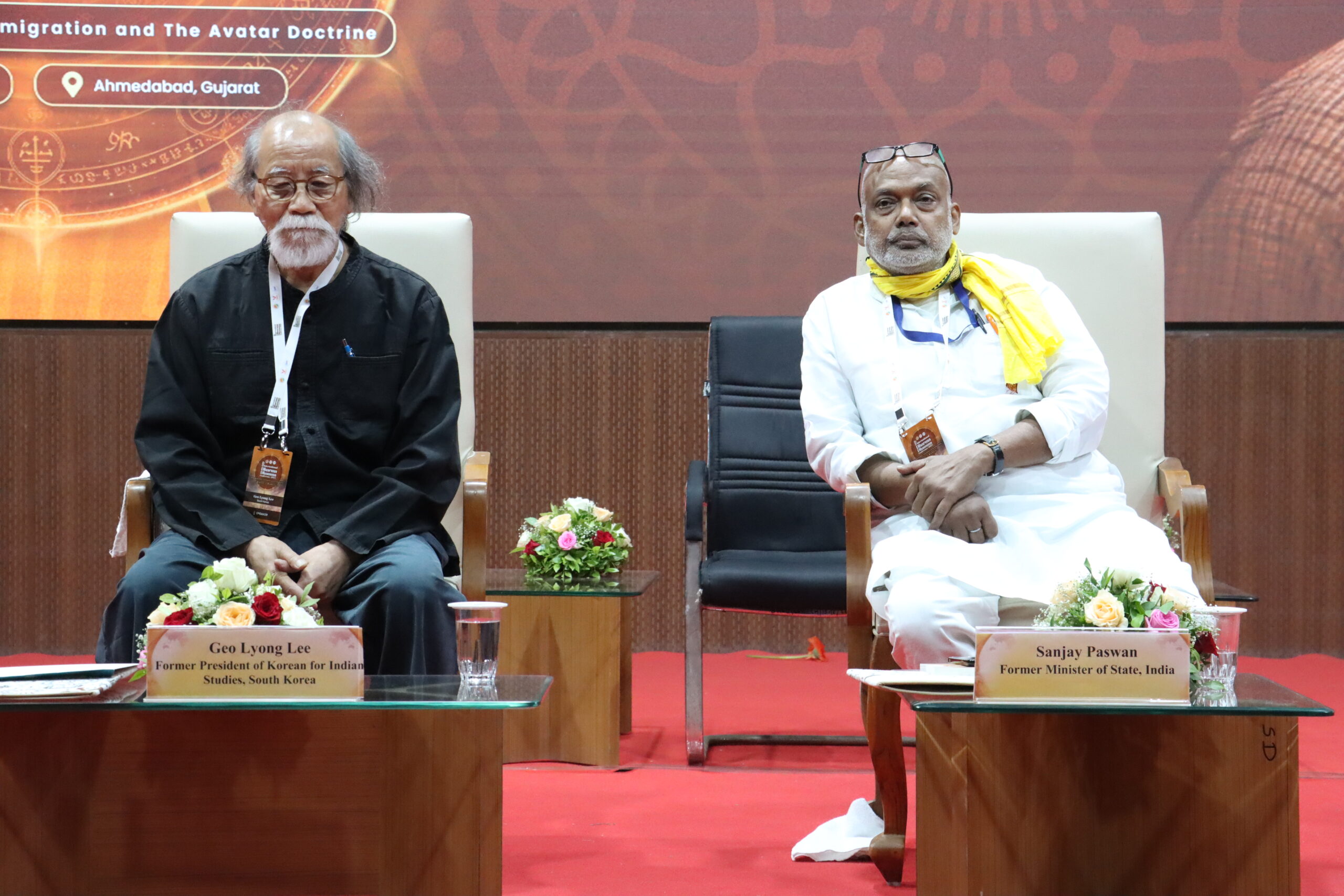
The session was chaired by Dr. Sanjay Paswan, Former Minister of State, India, who emphasized that self-discovery is realized through Dharma and spirituality, while yoga offers a vital path to stress reduction and inner balance. He reflected that every religious tradition begins as an idea, evolves into a belief, and ultimately matures into a philosophy. Citing India’s rich philosophical heritage, he noted how its scriptures and traditions have illuminated the global understanding of spirituality. He further remarked that the Dharma Dhamma Conference, as an international platform, enables diverse philosophical perspectives to converge, reinforcing that philosophy is the path to awakening the consciousness of the mind.
The memorial lecture was delivered by Prof. Geo Lyong Lee, Former President of the Korean Society for Indian Studies, South Korea, who began with a poem dedicated to Prof. S. R. Bhatt. In his address, he explored the profound influence of Ramanujacharya’s Vishishtadvaita Vedanta while drawing insightful comparisons between Shankaracharya’s Advaita Vedanta and Korean philosophical traditions, underlining their shared dimensions. He reflected on the philosophical inquiry into the origin of the universe and stressed that, in the present era, humanity’s foremost goal must be peace. He also highlighted Korea’s historical role as a significant center of Buddhism, illustrating the deep spiritual ties across civilizations.
The session concluded with a vote of thanks by Dr. Rajiv Bhatt, son of Late Prof. S. R. Bhatt, who expressed heartfelt gratitude to the speakers, dignitaries, organizers, and participants for honoring the memory of his father and contributing to the success of the memorial lecture.
Plenary Session 1 –Day 2

Chaired by Prof. Sunaina Singh, Former Vice-Chancellor, Nalanda University, the session underlined the importance of comparative reflection: Prof. Singh recalled the widespread presence of transmigration doctrines—from Vedic and Buddhist thought to Pythagoras and Platonic currents—and urged participants to situate the conference’s debates within long genealogies of thought while exploring shared parameters across traditions.
Swami Mitrananda, Spiritual Teacher, Chinmaya Mission, stressed the centrality of spiritual discipline and the graded methods of sadhana that accommodate seekers at different stages. He outlined four pragmatic stages of inner evolution—from outwardly driven action to dedicated japa practice and, ultimately, to steady meditation—and argued that if formal meditation proves difficult one may begin by dedicating all actions to the Divine or practising detached action (karma-phala vairagya). His exposition highlighted the inclusivity of Indian spiritual systems, which prescribe different practices for different temperaments and thereby make inner transformation widely accessible.
Dr. Supachai Veerapuchong, Secretary-General, BodhiGayāVijālaya 980 Institute, Thailand, described his institute’s applied work—Dhamma Yatras, SAMVAD talks and community projects—and opened with a short documentary showcasing those initiatives. He argued that the true “motherland” is where Dharma is embodied, not merely studied, and emphasised simple ethical injunctions (rooted in the five precepts) and mindful breathing as practical tools to control emotion, reduce suffering and make spiritual teachings lived realities. Drawing on personal testimony, he urged leaders to first listen, then reflect, and finally implement Dharma’s principles in public life.
Mr. Maris Sangiampongsa, Former Minister of Foreign Affairs, Thailand, traced the institutional history behind regional Dharma initiatives and reflected on his own ordination and transformation. He described how ordinary professionals—business people, civil servants and ministers—have been renewed through disciplined practice, and he presented the institute’s mission to translate Buddhist principles into everyday business ethics and collaborative models. Emphasising Asia’s centrality in the twenty-first century, he advocated applying Dhamma to foster cooperation rather than competition among nations and enterprises.
Prof. Il Soo Moon, Director, International Sati Institute; Emeritus Professor, Dongguk University College of Medicine, South Korea, introduced a neuroscientific reading of Buddhist psychology, framing mind-space as a subjectively constructed virtual field that arises during perception. Drawing on concepts such as anusati(recollection/memory image) and classical accounts in the Saṃyutta Nikāya, he explained how perceptual influxes shape mental representations and how disciplined practice can modulate these processes—thereby linking ancient doctrinal categories to contemporary cognitive neuroscience.
Plenary Session 2 – Day 2
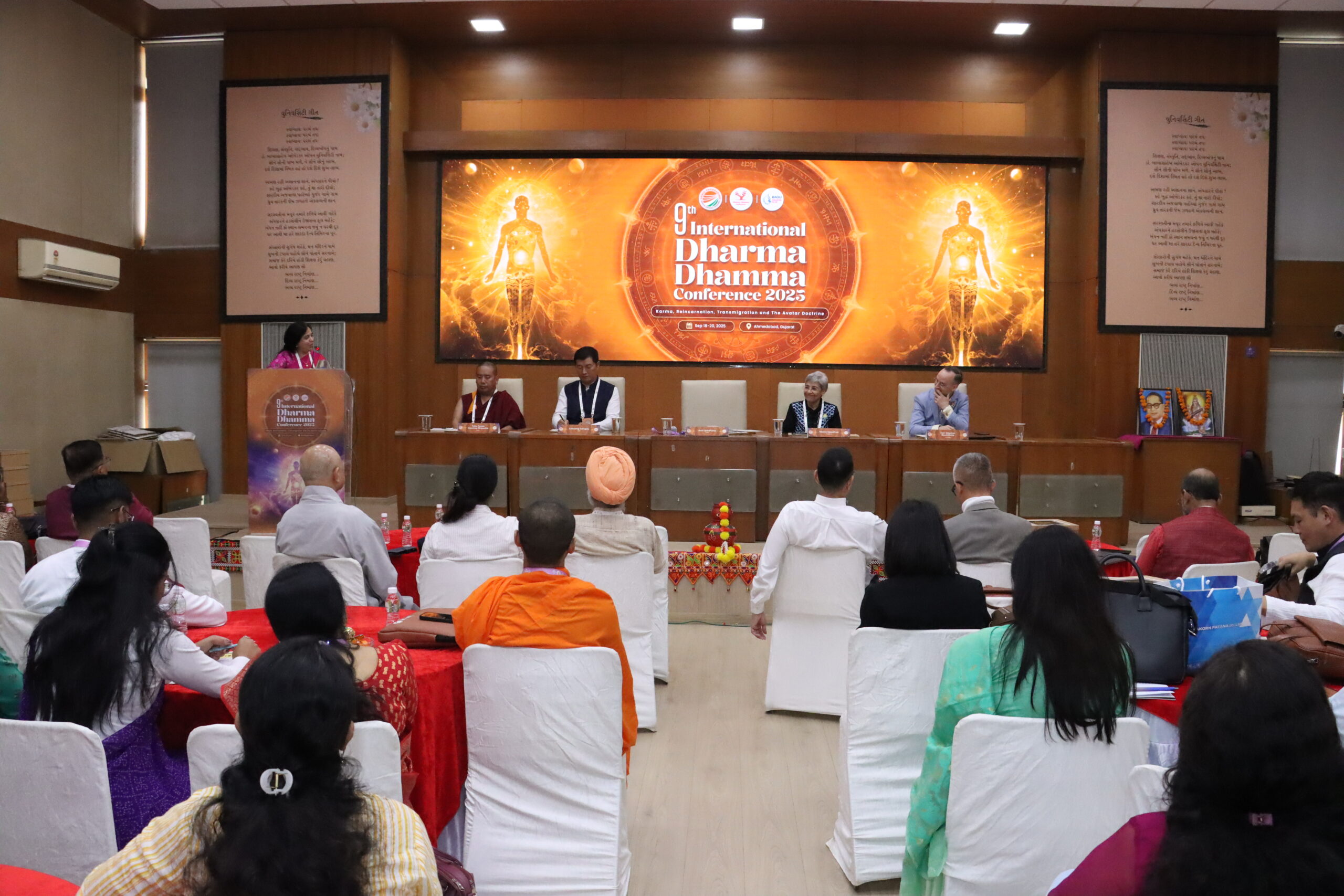
Prof. (Dr.) Ami Upadhyay, Vice Chancellor, Dr. Babasaheb Ambedkar Open University, Gujarat, reflected on the deep connection between Dr. B. R. Ambedkar and Buddhism, linking the Dashavatara tradition, karma, and classical dance as a medium of spiritual and cultural expression. Quoting “Yatho manah thatho bhava” (as is the mind, so is the becoming), she emphasized the importance of mindfulness in one’s actions and explained how karma makes the journey of life continuous, mirrored in the cycle of birth and rebirth.
Ms. Veena Upadhya, Assistant Secretary-General for Foreign Affairs, BodhiGayāVijālaya 980 Institute, Thailand, spoke on the role of karma and reincarnation in shaping human destiny, noting how Buddha’s visions of past lives and his conscious decision to teach highlight the inescapability of karma. Drawing on the Upanishads and Buddhist teachings, she underlined the importance of awareness, good actions, and the Eightfold Path, stressing that true peace lies within and that purification of the mind transforms life and community.
Dr. Karl-Stéphan Bouthillette, Professor, Manipal Academy of Higher Education, examined karma as both problem and paradox, arguing that in Jainism and Buddhism it was not a guarantee of cosmic justice but a mechanism binding beings to saṁsāra. He described renunciation as “ascetic resistance”—a refusal to participate in the karmic economy of worldly life. While acknowledging modern reinterpretations of karma as activism and ecological care, he warned that celebrating action may reinforce the very cycle traditions sought to escape, urging detachment, clarity, and a recognition that samsara “was never great and cannot be repaired.”
Tulku Tenzin Gyurmey Rinpoche, Founder, Thubten Shedrubling Foundation (TSF), Tawang, offered an in-depth explanation of the Tulku system in Tibetan Buddhism, grounding it in the Mahayana ideal of bodhisattvas returning to the world out of compassion. He outlined the history of reincarnation in Tibet, beginning with the Karmapa in the 12th century, and explained why High Lamas reincarnate—through karmic connections, prayers of compassion, and disciples’ requests. He detailed the rigorous procedures for identifying reincarnations, including signs, tests, and oracles, and emphasized that the system is rooted in both philosophy and devotion.
Dr. Lobsang Sangay, Senior Visiting Fellow, East Asian Legal Studies Program, Harvard Law School; and Former Sikyong (President) of the Central Tibetan Administration, spoke candidly about India’s place in history and the present. He contrasted the concept of karma with contemporary global crises such as wars, authoritarianism, and refugee flows, questioning why self-correction seems absent. He highlighted India’s ancient role as a center of knowledge and Buddhist diplomacy under Ashoka, and urged investment in infrastructure, institutions like Nalanda, and Buddhist cultural diplomacy. Warning that China has outpaced India in Buddhist soft power, he called for revival of India’s heritage to regain leadership in the global spiritual and cultural sphere.
Plenary Session 3 – Day 3
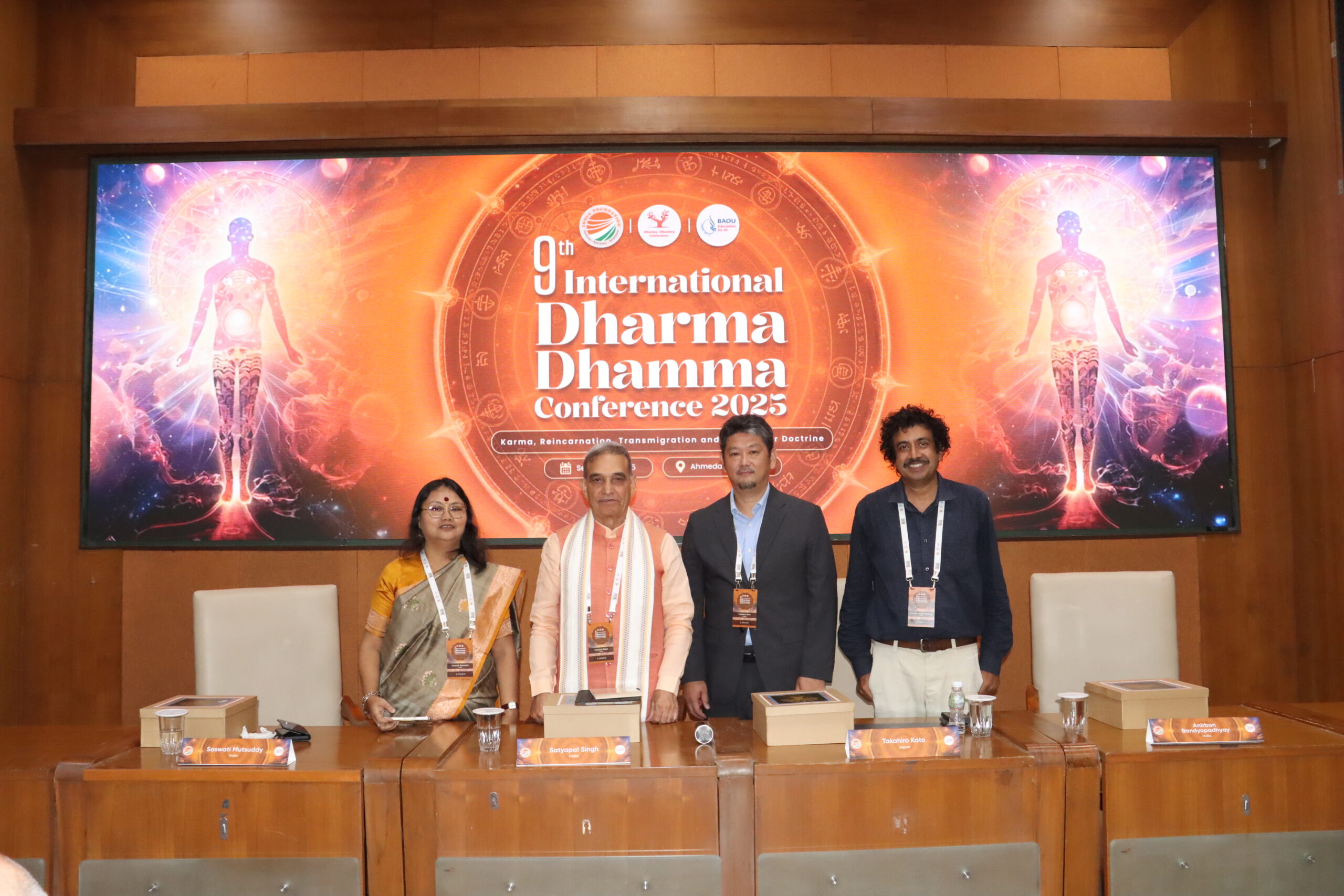
The third plenary session of the 9th International Dharma Dhamma Conference deepened the exploration of the theme “Karma, Reincarnation, Transmigration and The Avatar Doctrine” by weaving together perspectives from philosophy, science, and Buddhist studies.
Dr. Satyapal Singh, Former Chancellor, Gurukul Kangri University, Haridwar, and Former Union Minister of State, India, chaired the session. He emphasized that the theme of the conference touches the very essence of life, observing that the true path to happiness lies in Dharma. Quoting Dharmo rakṣati rakṣitaḥ (Dharma protects those who uphold it), he underlined that Dharma and Dhamma are universal, transcending boundaries of faith or culture. He also drew attention to the idea of cosmic consciousness and reflected that the roots of the Vedas are, in essence, the roots of science.
Prof. Takahiro Kato, Professor, Department of Indian Philosophy and Buddhist Studies, University of Tokyo, Japan, examined the relationship between karma, determinism, and moral responsibility. He explained how Indian traditions conceptualize karma not only as individual action but also as a shared responsibility, drawing on Mīmāṁsā’s principle of beneficiary designation and Buddhist practices of merit dedication. Citing the Mahābhārata, he reflected on how Indian thought reconciles determinism with freedom, presenting a nuanced form of compatibilism in which actions are conditioned by the past but remain open to ethical choice in the present.
Dr. Anirban Bandyopadhyay, Senior Scientist, National Institute for Materials Science (NIMS), Tsukuba, Japan, brought a scientific and personal dimension to the discussion. Recalling the experience of witnessing death in his family, he connected his reflections to avatāra and reincarnation through the lens of Sāṅkhya philosophy and the debates of Maharshi Kapil. He introduced the framework of Kālacakra, describing it as the rhythm of time, existence, and consciousness, and linked these insights to modern medical science, where bodily vibrations and energy flows are central to understanding life. By presenting Kālacakra as a shared language between philosophy and science, he offered a bridge between ancient traditions and contemporary knowledge systems.
Prof. Saswati Mutsuddy, Professor and Head, Department of Pali, University of Calcutta, India, emphasized that karma forms the very foundation of existence in Buddhism, governed by the universal law of cause and effect. Quoting the Buddha’s injunction Appadīpo Bhavah (be a light unto yourself), she highlighted the importance of self-reliance and inner strength. She explained how the Pañchaśīla (Five Precepts) and the role of chetanā (intention) guide ethical action, and stressed that no karma is without consequence. She further reflected on samādhi as the active discipline of the mind, clarifying that calmness is not passivity but cultivated clarity and strength, vital for understanding reality and moving toward liberation.
Plenary Session 4 – Day 3
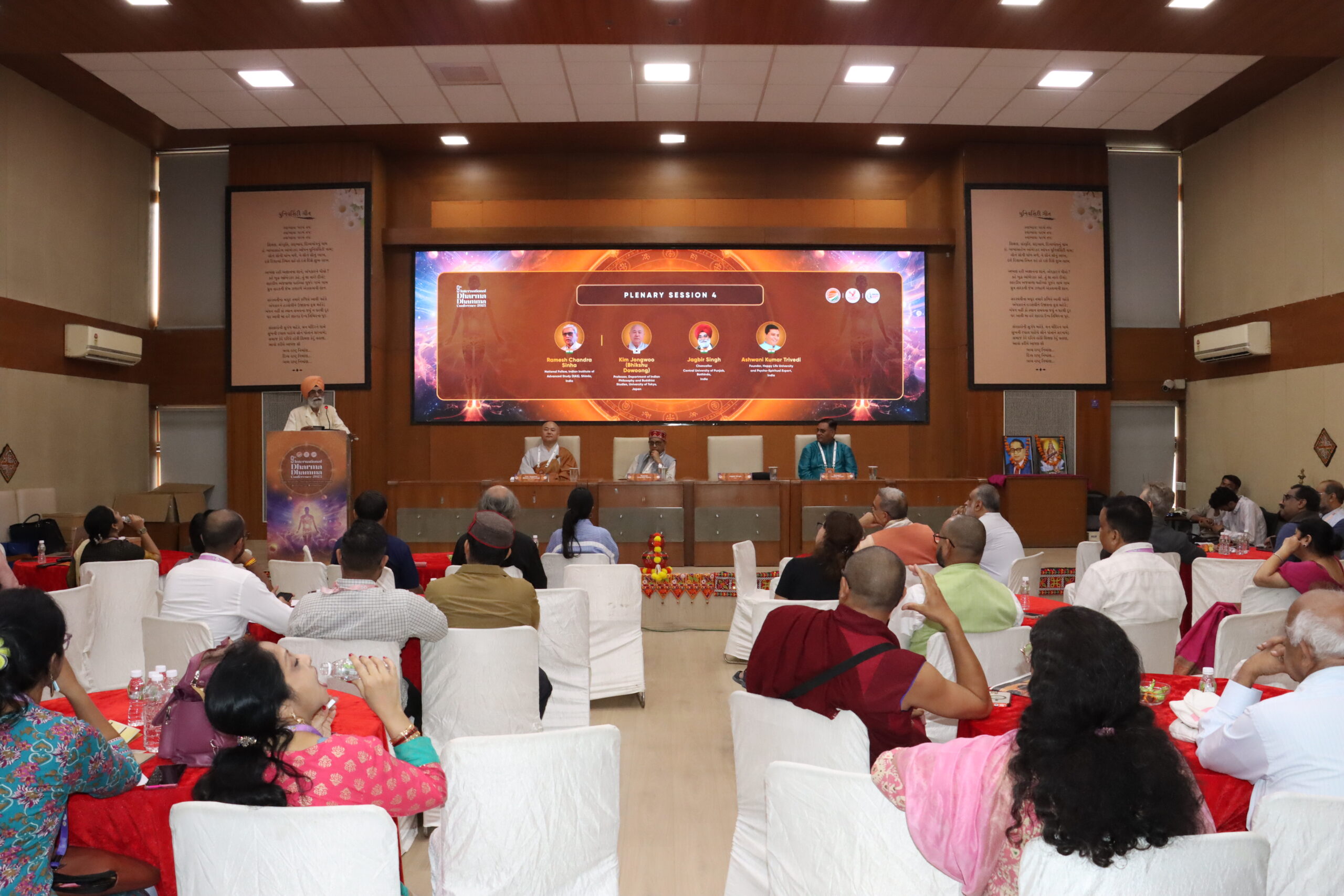
The fourth plenary session of the 9th International Dharma Dhamma Conference continued the dialogue on “Karma, Reincarnation, Transmigration and The Avatar Doctrine”, highlighting philosophical, cultural, and psycho-spiritual perspectives.
Prof. Ramesh Chandra Sinha, National Fellow, Indian Institute of Advanced Study (IIAS), Shimla, India, chaired the session. He emphasized the profound significance of the central theme and reflected on the depth of the concept of karma and the broader karma theory. He noted that the study of karma transcends a single tradition, representing a meaningful fusion of cultures and serving as a bridge for dialogue and understanding between diverse philosophical heritages.
Prof. Jagbir Singh, Chancellor, Central University of Punjab, Bathinda, India, highlighted the deep connection between Sanatan Dharma and the Sikh tradition. He observed that while Sanatan Dharma represents the ancient, the Sikh parampara reflects the new, yet both share the same cultural and spiritual continuum. Citing scholars such as Max Arthur Macauliffe, he discussed the enduring vibrancy of Sikh civilization, the unbroken lineage of knowledge (jñāna parampara), and the teachings of Guru Nanak Ji. He referred to the Ṛgveda’s eternal truth, “Ādi Sach, Jugādi Sach,” connecting it to Vedic concepts of Om and Brahman as the ultimate reality (Satyam Jñānam Anantam Brahma), and reflected on the relationship between the individual soul and the supreme Brahman.
Mr. Kim Jongwoo (Bhikshu Dowoong), Korea Sanskrita Shiksha Sansthanam (KSSS), South Korea, discussed the role of scripts and languages in preserving and transmitting cultural and spiritual heritage. He highlighted the historical significance of Devanagari and Brahmi scripts in Buddha Dharma and emphasized the meticulous rules guiding sacred text translation across regions. He also reflected on Buddhist art and sculptures as carriers of Dharma. Drawing parallels to Korea, he described the creation of the Hangul script, woodblock mantras, and the architectural and spiritual significance of Korean Buddhist temples, underscoring the deep interconnections between language, art, and living Buddhist tradition.
Mr. Ashwani Kumar, Founder of Happy Life University and psycho-spiritual expert, presented a consciousness-centered perspective on karma and energy. He emphasized that all beings are constantly in action, but the nature of karma varies across life forms—guided by instinct in animals, and by both instinct and intellect in humans. Highlighting the human tendency to be ensnared by the illusions of maya, he explained that true karma is measured by conscious alignment with dharma and divine will rather than mere outcomes. He outlined the soul’s journey through reincarnation and transmigration and illustrated the concept with the analogy of a spiritual GPS, termed God’s Guidance System (GGS), which directs the soul toward its ultimate cosmic purpose.
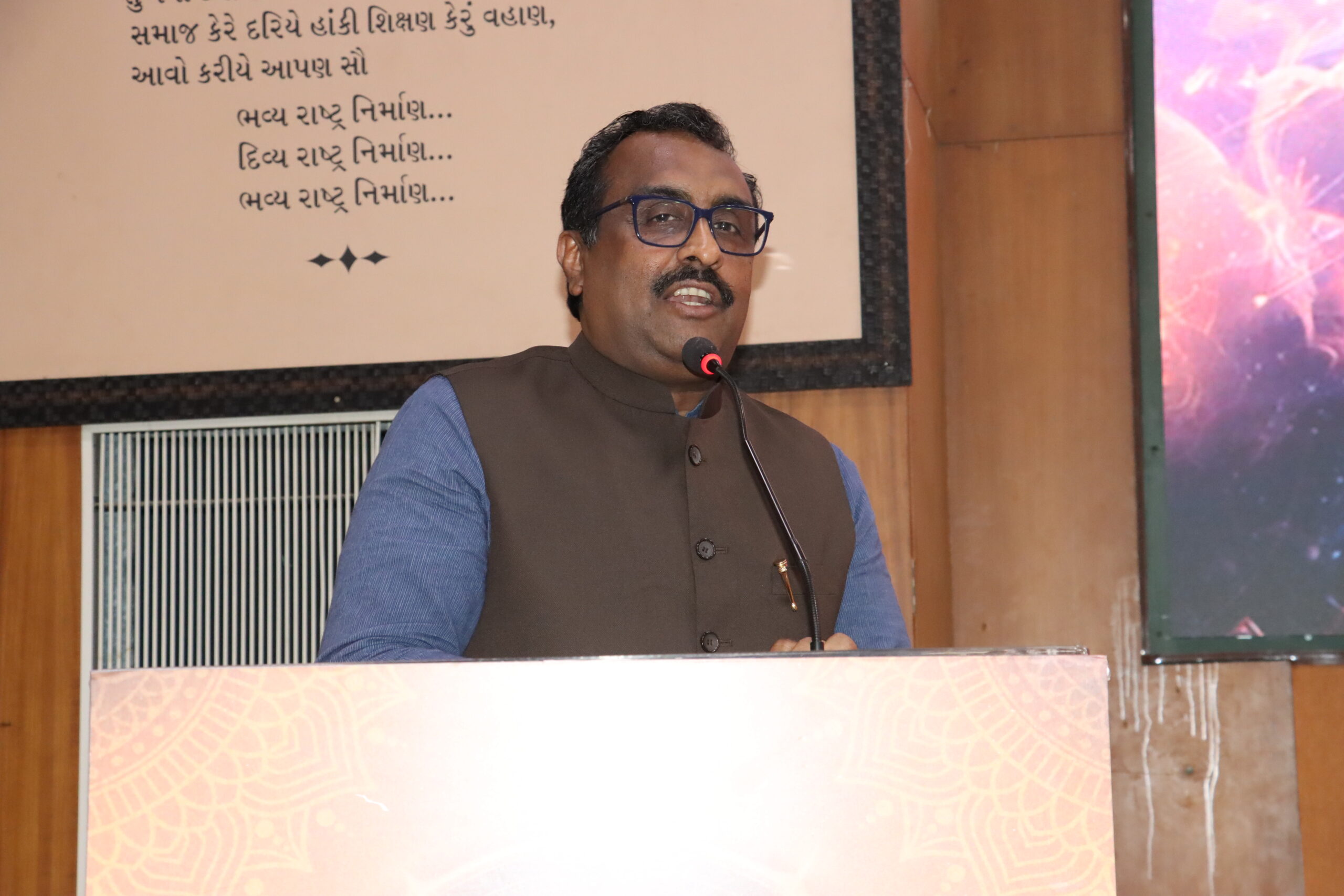
Dr. Ram Madhav, President, India Foundation, delivered the concluding remarks, reflecting on the intricate interplay between the theme of the conference and consciousness and emphasizing that individual perception significantly shapes the realization of future outcomes. He highlighted the importance of empirical research to further deepen understanding in these domains and underscored the ongoing need for rigorous scholarly inquiry into the principles of Dharma and Dhamma.
High-Level Policy Dialogue on “Clean, Green, and Resilient Pathways to a Viksit Bharat”
1. Introduction
On 16 September 2025, the India Foundation and Dalberg Advisors jointly convened a High-Level
Policy Dialogue in New Delhi to deliberate on strategic approaches to realizing the vision of Viksit
Bharat @ 2047 – a developed, inclusive, sustainable, and resilient India. This gathering brought
together senior policymakers, business leaders, civil society representatives, academics, and
international experts. The dialogue focused on aligning India’s economic aspirations with a robust
climate strategy, making the case that climate action is not merely an environmental imperative
but a central pillar of national growth and competitiveness.
Participants agreed that integrating climate considerations into India’s development framework is
essential to safeguard productivity, ensure resilience, and maintain global leadership. As India sets
its sights on becoming a $30 trillion economy by 2047, the dialogue underscored the need to
embed sustainability into every level of economic and social planning.
2. Strategic Themes and Insights
2.1 Climate Resilience as Economic Strategy
Climate resilience was recognised as a foundational requirement for sustained economic output.
Projections indicate that without timely adaptation, India could face economic losses exceeding
$1.5 trillion by 2050, particularly in high-risk sectors such as agriculture, MSMEs, and urban
infrastructure. Given that over 85% of India’s districts are climate-vulnerable, the dialogue called
for urgent investments in resilient urban planning, adaptive agriculture, and protective
infrastructure.
Building resilience now will not only mitigate future disaster-related costs but also preserve
productivity and enhance social equity. Policy mechanisms that support climate-proofed
infrastructure and climate-smart agriculture were identified as immediate priorities.
2.2 Energy Transition and Green Electrification
India’s energy demand is expected to rise sharply, reaching 708 GW by 2047. To meet this need
while decarbonising the economy, the transition to clean electricity, green hydrogen, and bioenergy
must accelerate. The National Electricity Plan projects that 90% of India’s power should come from
non-fossil fuel sources by 2047.
The dialogue introduced the concept of “Electricity as the next UPI” – a digitally integrated, low
cost power grid that uses AI, IoT, and blockchain to reduce system losses and improve efficiency.
Participants stressed the need for robust policy and investment to support the development of this
infrastructure, while ensuring energy access remains equitable.
2.3 Green Trade and Supply Chain Resilience
India’s ability to compete in the global marketplace increasingly depends on carbon
competitiveness. With 68% of Indian exports destined for net-zero economies, failure to
decarbonise industrial production could result in restricted market access and loss of export
revenue.
Climate-induced disruptions such as floods and heatwaves already threaten manufacturing hubs
and logistics networks. The dialogue stressed the importance of investing in low-carbon
manufacturing, resilient infrastructure, and clean logistics. Strategic upgrades to export-oriented
industrial clusters were highlighted as vital for maintaining India’s trade leadership.
2.4 Financing the Green Transition
To meet its net-zero and climate resilience goals, India requires an estimated $150–170 billion in
annual green investment. The operationalisation of a national climate finance taxonomy was
identified as a critical enabler. This framework would provide clarity to investors, reduce
greenwashing, and support the flow of public and private capital.
Participants called for the expansion of blended finance models and de-risking mechanisms to
unlock private investment, especially in sectors with long payback periods. The importance of
developing a pipeline of bankable projects was also emphasised to catalyse institutional financing.
2.5 Global Leadership Through Climate Diplomacy
India’s growing influence in the global south presents an opportunity to shape international climate
agendas. Initiatives such as the International Big Cat Alliance, International Solar Alliance, and
Global Biofuels Alliance serve as platforms to demonstrate leadership in biodiversity conservation
and clean technology.
The dialogue encouraged the government to leverage these platforms, along with global forums
such as COP33, to promote India’s green development model and deepen South-South
cooperation on technology, finance, and climate resilience.
3. Sectoral and Governance Priorities
India’s conservation strategy must aim to expand protected areas to 10% of total land and maintain
at least 30% forest cover by 2047. This will require scaling flagship initiatives like Project Tiger, the
Cheetah Reintroduction Program, and the International Big Cat Alliance. These efforts should be
integrated with development planning and backed by strong governance and enforcement
mechanisms.
The MSME sector, comprising over 63 million enterprises, plays a pivotal role in employment and
exports but remains highly vulnerable to climate impacts. Support mechanisms such as green
financing, cluster-based innovation hubs, and digital transformation tools are essential to enable a
just transition.
Technology and innovation must drive India’s climate and development agenda. Key investment
areas include hydrogen R&D, AI-enabled climate analytics, circular economy solutions, and low
emission agricultural practices. Research institutions and private enterprises require targeted
policy and funding support to accelerate technology deployment.
Subnational governments are central to climate implementation. Empowering states and districts
through mandatory climate risk assessments, adaptation planning, and financial devolution will be
essential. Cooperative federalism must guide this approach, particularly in vulnerable regions like
Bihar, Odisha, and the Indo-Gangetic belt.
Lastly, inclusive development must remain the cornerstone of India’s climate strategy. Engaging
youth through platforms such as Viksit Bharat @ 2047: Voice of Youth, expanding sustainable
housing, and integrating climate considerations into public health are key to building community
resilience.
4. Policy Recommendations
To translate these deliberations into actionable reforms, the dialogue outlined seven core policy
directions.
First, climate priorities must be embedded across all levels of economic policymaking. From fiscal
frameworks and industrial policy to infrastructure design, climate considerations must guide
investment decisions and resource allocation.
Second, India must rapidly scale up green finance. This includes full operationalisation of the
climate finance taxonomy, development of de-risking instruments, and enhanced coordination
between public agencies and private investors to mobilise the necessary $150–170 billion
annually.
Third, conservation goals must be scaled significantly. Expanding protected areas, restoring
degraded ecosystems, and achieving zero poaching of Schedule-I species should be embedded in
India’s development and land-use frameworks.
Fourth, cleantech innovation must be fast-tracked. Government and private sector R&D
investment should prioritise hydrogen, biofuels, AI-powered energy solutions, and sustainable
agriculture technologies. National institutions must be empowered to lead this innovation drive.
Fifth, subnational governance must be strengthened. States and municipalities need technical and
financial support to conduct climate risk assessments and implement adaptation strategies.
Cooperative federalism will be key to ensuring that climate goals are met across diverse
geographies.
Sixth, MSMEs must be enabled to adopt green practices. Dedicated green financing lines, capacity
building programs, and digital infrastructure are needed to help small enterprises stay competitive
and resilient.
Seventh, inclusivity must anchor all efforts. Policies must prioritise youth engagement, promote
affordable green housing, and integrate climate-health linkages into public systems. Community
led conservation and adaptation models should be scaled to ensure local ownership and impact.
5. Conclusion
The High-Level Dialogue reaffirmed that India’s path to becoming a developed economy by 2047
must be clean, green, and resilient. Climate action is not a constraint on growth; it is the most
strategic enabler of sustainable prosperity and global competitiveness.
India has the opportunity—and the imperative—to lead the global green transition. The insights and
recommendations generated through this dialogue offer a roadmap to accelerate climate-smart
development. India Foundation and Dalberg Advisors remain committed to supporting the Ministry
of Environment, Forest and Climate Change in translating these priorities into policy, partnerships,
and implementation frameworks for a climate-resilient Viksit Bharat.
Chair: Dr. Ram Madhav, President, India Foundation
Special Addressee: Mr. Jayant Sinha, Former Minister of State, Government of India
Invitees for the High-Level Strategic Interventions
1. Ms. Akshima Tejas Ghate, Managing Director, Rocky Mountain Institute India
2. Dr. Alok Sikka, Country Representative – India, International Water Management Institute
3. Dr. Amit Kapoor, Chair, Institute for Competitiveness
4. Mr. Amit Prothi, Director General, Coalition for Disaster Resilient Infrastructure
5. Ms. Archna Vyas, Global Director of Policy and Communications, Gates Foundation
6. Ms. Cecilia Tall, Counsellor for Science and Technology, Embassy of Sweden
7. Ms. Charu Chadha, Consultant – Asia Regional Office, The Rockefeller Foundation
8. Mr. Deo Datt Singh, Director, People’s Action for National Integration
9. Mr. Jatinder Cheema, Principal, JC Law Advocates and Solicitors
10. Mr. Kamlesh Kumar Mishra, Joint Secretary, 16th Finance Commission, Government of India
11. Mr. Koyel Kumar Mandal, Director, Climate – India, Children’s Investment Fund Foundation
12. Ms. Mahua Acharya, Founder and CEO, International Energy Transition Platform
13. Dr. Manoj Singh, Additional Member, Railway Board, Government of India
14. Mr. Mudit Narain, Energy Advisor, Social Alpha
15. Mr. Nabin Kumar Roy, General Manager, National Bank for Agriculture and Rural Development
16. Mr. Pawan Mulukutla, Executive Programme Director, World Resources Institute India
17. Mr. Randheer Singh, Founder and Chief Executive Officer, ForeSee Advisors
18. Dr. Ravindra Kumar Singh, CGM, Small Industries Development Bank of India
19. Dr. Satya Prakash Yadav, Director General, International Big Cat Alliance
20. Ms. Seema Paul, Programme Director, Sequoia Climate Foundation
21. Dr. Sharath Rao, Fellow, Centre for Social and Economic Progress
22. Mr. Shombi Sharp, United Nations Resident Coordinator in India
23. Mr. Vaibhav Pratap Singh, Executive Director, Climate and Sustainability Initiative
24. Mr. Vivek Sen, India Director, Climate Policy Initiative
Curators
1. Mr. Jagjeet Singh Sareen, India Head, Dalberg Advisors
2. Mr. Shashvat Singh, Senior Research Fellow, India Foundation
Interaction with Ms. Maja Groff
On September 16, 2025, India Foundation organised an interaction on the topic, “Global Governance Solutions to the Climate Crisis.” The speaker, Ms. Maja Groff, is an author, international lawyer, and Convenor of the Climate Governance Commission, which empowers organisations and leaders to focus their efforts on transitioning to a net-zero, climate-resilient economy. The interaction was attended by an eminent group of policy advocates and practitioners working on climate change. The interaction was chaired by Mr. Côme Carpentier, Distinguished Fellow at the India Foundation, who, after welcoming the speaker, briefly set the background for the talk, underscoring the frequency of extreme climate events and the polarizing world opinion on climate action.
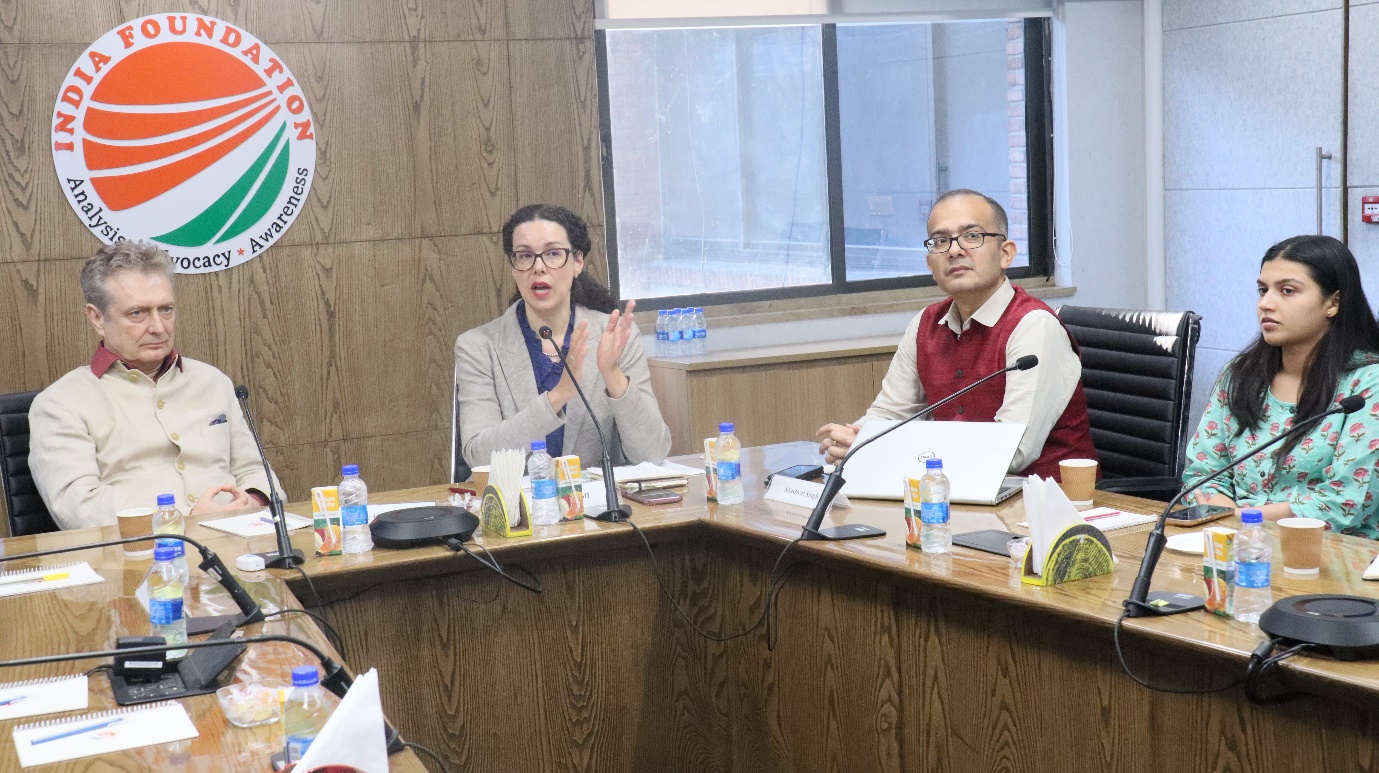
Ms Maja Groff commenced the interaction by offering an overview of the Climate Governance Commission, which comprises of 19 eminent persons, including former heads of states, former ministers, boasting of a diverse geographic representation.
She underscored that the current predicament posed by the climate crisis offers an opportunity for streamlining international governance of the environment. She advocated for a comprehensive approach to planetary boundaries, which necessitates a system of Earth governance. Cautioning that 6 of the 9 planetary boundaries of the ecology had already been breached, she brought attention to the impact of climate change on the global economy, which, due to climate crises and disasters, is expected to shed 19% of its GDP. Insurance and actuaries have borne the immediate brunt of the economic effects of climate change, as insuring against increasingly unpredictable, all-encompassing, and cascading effects of climate change becomes a challenge.
Ms Groff underlined the need to protect all ecological systems, treating climate and biophysical systems as the common heritage of humankind. Outlining the intent of the organisation to advocate for institutionalisation of this principle to facilitate collective management, she opined that legal–institutional arrangements must espouse adaptive models of governance to address the fast-evolving circumstances. While agreeing that frameworks have contributed to devising strong norms, she opined that the proliferation of bilateral agreements has not been accompanied by timely implementation.
She demonstrated the contribution of the Climate Governance Commission toward developing tangible, time-bound policy proposals—e.g., during the Conference of the Parties (COP) in 2023—to fashioning next-generation institutions and empowering the United Nations Environment Programme. She described the need to de-fragment existing institutions and create emergency platforms to absorb global climate shocks and risks. Furthermore, she informed the guests of the Commission’s plans to prioritise proposals for the upcoming COP in Brazil. She concluded her remarks by emphasising the need for a corporate ecosystem, which will emerge from an alliance of the private sector and civil society, advancing a like-minded approach for reforms to face transnational challenges.
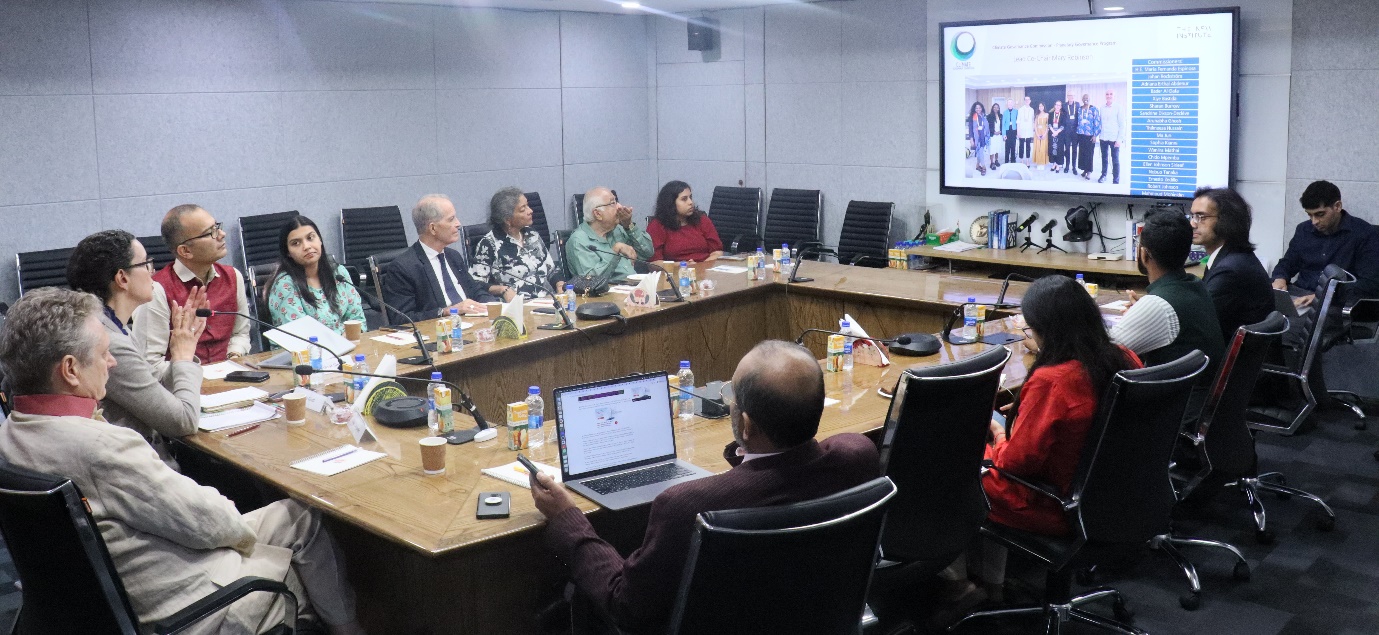
A lively round of Q/As followed, where the recent policies of the Trump Administration on climate management drew the attention of the guests. Ms Groff traced the frequent changes in climate policies brought about by shifts in dispensation in Washington, DC, since 2015. The discussion also revolved around the alternative arrangements and policy leaders in the event of the US retrenchment from international climate governance. Ms Groff argued that, given the gravity of climate risks and their economic consequences, alternative centres like the BRICS and the European Union must fill the void left by US policies on the environment and climate finance.
Ms Groff was felicitated by Capt. Alok Bansal, Executive Vice President, India Foundation.
IF-IHC Panel Discussion on ‘Analysing the Trajectory of the Indo-U.S. Relations’
India Foundation, in collaboration with the India Habitat Centre, organised a panel discussion on ‘Analysing the Trajectory of Indo-US Relations’ on 11 September 2025 at India Habitat Centre, New Delhi. The session brought together distinguished experts like Prof C. Raja Mohan, Distinguished Fellow, CSDR; Visiting Professor, ISAS, NUS; and Chair, Editorial Advisory Board, India’s World; Ms. Barkha Dutt, Senior Journalist and Editor, Mojo Story; and Shri Arun Kumar Singh, Former Ambassador of India to the United States, Israel, and France. The discussion was moderated by Captain Alok Bansal, Executive Vice President, India Foundation. The panel deliberated on the evolving contours of the Indo-US partnership, focusing on opportunities, constraints, challenges, and possible trajectories for the future.
Prof C. Raja Mohan opened the discussion by questioning the pace at which major powers recalibrate their relationships. He highlighted the robust $200 billion bilateral trade ties between India and the United States, observing that “trade issues are serious although negotiable.” He underlined that traditional flashpoints such as Jammu & Kashmir, nuclear weapons, and Pakistan have receded in salience, while trade has emerged as the central issue. Stressing that diplomatic engagement alone cannot resolve trade frictions, he called for self-reflective economic reforms within India, adding: “Relationships will continue to change. We need to adapt and analyse them.”
Ms. Barkha Dutt offered a perspective on America’s internal polarisation, remarking that political violence has been historically ingrained in its society. She argued that the United States today appears to be “dissembling and diminishing.” Noting India’s delicate balancing act, she stated: “We are faced with a deeply opaque China and a deeply volatile United States. India seems to be walking a tightrope.” She added that for the common citizen, Indo-US relations are less about technical trade negotiations and more about sovereignty and autonomy—about not being bullied.
Amb Arun Kumar Singh traced the trajectory of Indo-US relations into the future, pointing out that while political leadership may be fragmented, functional cooperation between the two nations continues steadily. He acknowledged the United States’ position as the world’s leading economic power and argued that India cannot afford to neglect this relationship: “The US offers to India what Russia cannot. We have no option but to build this relationship.” He cautioned, however, that India must hedge and diversify its partnerships to preserve autonomy, noting that over-dependence could mirror the vulnerabilities faced by Europe, Japan, Indonesia, and Vietnam. He urged the US to build a “partnership of confidence with growing convergence.”
Captain Alok Bansal, in his concluding reflections, drew a cultural distinction between occidental societies like the US, which readily adapt to changing circumstances, and oriental societies like India, which are more rooted in sentiment and slower to change. He highlighted that if, even in the aftermath of 9/11, trade rather than geopolitics or security remains a key theme in India-US discussions, it demonstrates the centrality of economic issues. He further observed that America’s real leverage over India lies not in tariffs but in visa restrictions, which significantly impact people-to-people linkages.
The discussion underscored that while the Indo-US relationship is evolving amidst shifting and economic contexts, it remains indispensable for both countries. Trade has emerged as the defining axis, even as strategic, political, and cultural considerations continue to shape the engagement. The panel agreed that India must pursue reforms, balance partnerships, and assert its autonomy, while the US must strive to build a relationship grounded in confidence and convergence.
Briefing by the Ambassador Extraordinary and Plenipotentiary of Japan to India and Bhutan, H.E. ONO Keiichi
On September 8, 2025, India Foundation organised a closed-door briefing with the Hon’ble Ambassador Extraordinary and Plenipotentiary of Japan to India and the Kingdom of Bhutan, H.E. Mr. ONO Keiichi. The briefing was focussed on the outcomes and opportunities from the two-day visit of India’s Prime Minister Shri Narendra Modi to Japan from August 29-30, 2025, as well as his meeting with his Japanese counterpart, the then-Prime Minister Shigeru Ishiba. The briefing was chaired by Captain Alok Bansal, Executive Vice President of India Foundation, who welcomed the Ambassador and introduced the subject of the briefing. The briefing was attended by distinguished guests, including former military commanders, former diplomats, defence experts, journalists, and policy analysts with particular interest in the trajectory of Indo-Japan relations.
The discussions took place under Chatham House rules and, set against the backdrop of PM Modi’s visit to Japan, encompassed the whole gamut of the bilateral relationship. They focussed on the aspects of continuity and the expansion of the Special Strategic and Global Partnership in its 10th year. The briefing dwelled on the mutual complementarities explored during the visit, and the need for adopting a collaborative outlook on economic and security matters to provide clearer impetus to their strategic partnership. The discussions emphasised on the need for stronger cooperation in international institutions to weather the headwinds in geopolitics. The delegates concurred that the following Conference of Parties in Brazil will provide a critical platform for negotiations for just decarbonisation and climate financing pathways.
The briefing identified the potential for boosting private investment from Japan into India and the opportunities in India’s business environment, especially in its Northeast. The dignitaries also drove their attention to the strides made in technical and financial collaboration in high-speed rail mobility, as well as the potential for cooperation in next-generation mobility, meeting the countries’ climate targets, and achieving integrated spatial development in the areas served. The discussants explored opportunities in micro, small, and medium-scale enterprises (MSMEs), building resilient supply chains and logistical channels, and defence. The discussions also ranged the regional shifts in South Asia, Africa, and East Asia, and the potential for concerted action of Japan and India to provide solutions to shared problems.
The meeting ended on an optimistic note, as the participants lauded the progress of the bilateral partnership and expressed hope for the two countries to participate in each other’s economic development. After a lively round of Q/As, the Ambassador was felicitated by Air Marshal (Retd) PK Roy, Member, Governing Council, India Foundation.
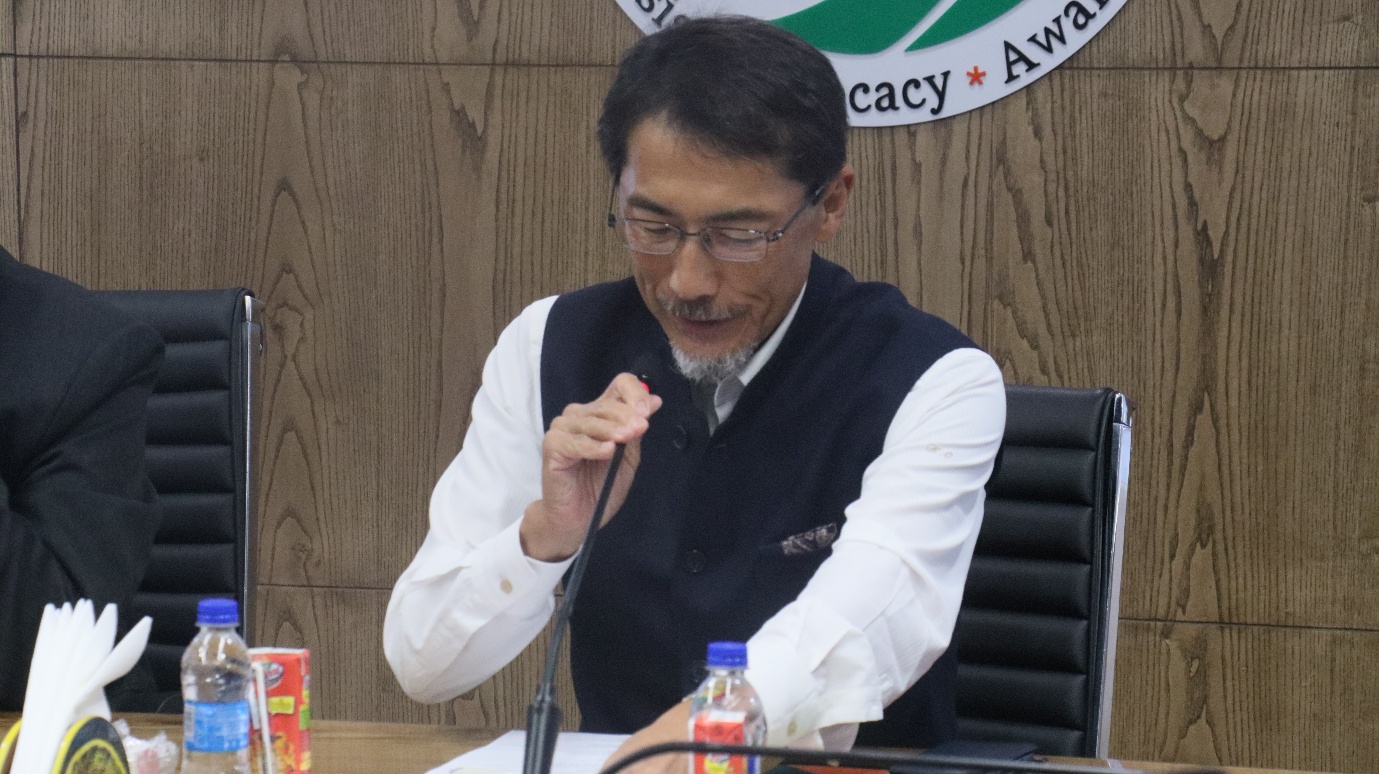
An Interview with Amb Shyam Saran, Former Foreign Secretary, on “India’s Neighbourhood: Navigating Geopolitical Shifts”
Dhruv C. Katoch:
We are living in highly volatile times. South Asia is not immune to the effects of global power politics, and for various reasons, the region is troubled by internal discord—political, economic, and security-related. In this podcast, we will discuss some issues concerning India’s neighbours. We are honoured to have Ambassador Shyam Saran to explore these topics. The Ambassador is one of the most respected voices on global and regional affairs. He has served as India’s Foreign Secretary and is also the recipient of the Padma Bhushan. Welcome, Ambassador. Let me begin with Bangladesh, with whom we have maintained very friendly relations, but those ties are now starting to fray. What are the main factors shaping Bangladesh’s current political and socio-economic situation, and how might these changes affect its internal stability as well as India’s security, trade, and the broader regional dynamics in South Asia?
Shyam Saran:
Thank you very much for inviting me to speak with you on topics that are very important for India’s foreign policy. So, concerning Bangladesh, as you said, we had an excellent run in a sense with Sheikh Hasina being in power. People sometimes complain that we put all our eggs in one basket, and we should have reached out to other political forces in Bangladesh. I think they neglect the fact that some very major positive developments took place during the past 15 years or so. We resolved the border issue, which had been pending for a very long time. We managed to get agreement, not 100%, but substantially, on the sharing of river waters. We established very strong cross-border connections with Bangladesh, including the revival of river transportation, which was once the lifeline for the northeast of the subcontinent. We became a major power source for Bangladesh’s industry. Without the supply of electric power from India to Bangladesh, the textile industry in Bangladesh would not have progressed as much as it did. We became a significant market for Bangladesh’s products, including textiles, which are their major export. In the security sphere, the sanctuaries that many of the insurgent groups used to have in Bangladesh came to an end. So, for anybody to say that we did not play this game right, I disagree with that. When an opportunity arose, we made full use of it. And even if the political pendulum swings to one side and we have to cope with the consequences of that, the pendulum can also swing to the other side, and we should be ready for that change. So, we should not get too panicky about the situation that has emerged. We should try to deal with it as best as we can.
One thing to consider is that, when examining the situation in Bangladesh, you must not forget its history. Remember that even when Bangladesh became an independent country, there was no complete political consensus, even within Bangladesh, regarding this separation from Pakistan. Nearly one-third of the population did not support Bangladesh’s separation from Pakistan. For example, the Jamaat, an influential force, although it doesn’t win elections, has never reconciled itself to the separation of Bangladesh. Several other people may be more inclined, as far as the attachment to Islam is concerned, to believe that being an Islamic country is more important than being a Bengali country. So, we have to be mindful of the fact that various forces are at work inside Bangladesh.
Regarding the domestic situation, we can do very little to influence those dynamics. So, what is the best course of action? The position that the Government of India initially took was communicated during the visit of our Foreign Secretary to Bangladesh. What message did he convey to the chief advisor? He stated that, despite any political relationship difficulties we may be facing, India will continue with the broad spectrum of cooperation we have always maintained with Bangladesh. This includes the supply of power to Bangladesh, cooperation on river waters, and providing access to our markets, including transit arrangements, which are very important for Bangladesh. We do not intend to interrupt these efforts, and we hope that, despite any political issues, Bangladesh will also recognise the value in maintaining this cooperation.
This is where political issues in Bangladesh have begun impacting some of our cross-border connections. How should we respond? I believe we should remain calm and continue to be prepared to cooperate whenever the other side is willing. However, when it comes to defending our interests, particularly our security concerns, we must be cautious. We need to be aware of where our interests are being affected, and nobody should doubt that if our interests are harmed in any way, we will take appropriate remedial action. Beyond that, we remain open to resuming cooperation with Bangladesh when the situation improves. We hold goodwill for the people of Bangladesh, as we have no issues with them. That should be our approach during this challenging time.
Dhruv C. Katoch:
Just a quick follow-up question: the elections are scheduled for February. First, do you think they will happen? Is it likely that they will (or should they) result in a democratic establishment? I mean, will they genuinely follow the democratic process, or will it simply be the Jamaat taking over?
Shyam Saran:
Well, the fact that they have said the Awami League cannot participate in these elections suggests that it may not be as democratic as one would hope, because the truth is that the Awami League is, in a sense, being marginalised within the political system. The fact that there is a concerted effort to try to delegitimise the Awami League shouldn’t be overlooked. Even today, 30% of the population still supports them. So, if you’re claiming that the preferences of at least 30% of your population cannot be considered, then how can it be truly democratic? We must take that into account. Incidentally, the BNP, which has been the main opposition party, also believes that a competitive political environment is necessary. They are not opposed to the Awami League participating in the election, or at least that’s the impression I have received. As for Jamaat, I am uncertain whether they will achieve significant gains in the polls, given that, as I mentioned, despite their influence, they have never secured a substantial number of seats in the Bangladesh Parliament.
We have observed that, whether or not they succeed in elections, they still become an influential constituency. Now, for the Jamaat, India is a warning sign because they blame us for the separation of Bangladesh from Pakistan. They also blame us for what they see as secularisation of the polity in Bangladesh. Therefore, as we see today, the Jamaat has gained a significant level of influence. If this situation continues and becomes, in a sense, institutionalised, then that is not very good news for India. However, we should also not underestimate the importance of the economic connection between India and Bangladesh. I am hopeful that many of the interdependencies established over the last 15 years or so will remain strong enough to help us through this period of some turmoil.
Dhruv C. Katoch:
Now I will move on to another country, our neighbour Nepal. Our relations with Nepal have traditionally been very close, especially considering the nature of family ties we have shared; there is a commonality of religion, culture, history, civilisation, and complete compatibility. However, we have tensions with them. There is a historical reason for this. Currently, internal problems within Nepal tend to influence the situation. These issues often impact the India-Nepal relationship. How do you see this playing out in the present climate in Nepal, where they face their own political and economic challenges, and China is also emerging as a significant player?
Shyam Saran:
I have been an ambassador to Nepal, and I believe I have some familiarity with the country, though perhaps not a great deal, but enough to know that the most important asset we possess regarding Nepal, which also applies to several neighbouring countries, is the people-to-people relations. Very strong people-to-people relations. You mentioned that we have these cultural links and familial ties, and by the way, the familial links are not only with the Madhesis and the states of Bihar and UP. There are also very strong familial connections with the so-called Pahadi population living in the hills. People tend to think it is only the Madhesis, but it is not. These are also very strong connections. Therefore, the challenge for India has always been how to leverage this very strong people-to-people and cultural affinity between the two countries to influence the state-to-state relationship positively. Because if there is a problem, it exists only there. It is not with the people; it is the political path.
One point I must emphasise is based on my own experience: you have to recognise that you are a very large country surrounded by smaller neighbours. It should come as no surprise that these neighbours may feel somewhat anxious about the possibility of being overshadowed by the larger power, which is natural. We often feel similarly when faced with a superpower, and we try to balance that influence. Therefore, we should not be overly sensitive about it. We need to understand what that implies, which is how we can develop a diplomacy of reassurance with our neighbours. This is especially important for a country like Nepal. The key is to show them that we genuinely wish them well and are willing to be partners in their economic and social development because that truly matters to them.
Now, two points regarding how we approach this. One of the challenges we face is the presence of various constituencies in Nepal. If you start saying ‘this is my friend’ or ‘this is not my friend’, it creates a problem. We must avoid being perceived as taking sides in what is essentially a domestic political dynamic. This is very important. India should not be seen as part of that. If we are not involved in that, we are in a much stronger position. The second point is that you should not view your relationship with Nepal solely through the lens of China. If every action in Nepal is framed by what you believe China is doing, you will encounter difficulties. Trying to match China in the way it exerts largesse, which I see as a kind of game, is not advisable. Why? Because you should leverage your areas of strength, rather than attempt to mirror Chinese strengths. This requires careful consideration. For example, consider one area — proximity. China faces more difficulties accessing Nepal than India. Isn’t that correct? Why is it that, despite years of efforts, the Chinese have been carving through mountains and building roads, or even talking about railways? Why, given our geographical advantage, have we not been able to achieve similar progress?
During my time as an ambassador in Nepal, I noticed that travelling from Nepal into India by road could give the impression that one was coming from a relatively developed country to a less developed one, given the poor state of our roads. Now, there has been a significant improvement in that regard. There has also been progress in attempting to revive, for example, some of the rail links that existed before. We have finally started working on a hydroelectric power cooperation between the two countries. These are positive developments, but with respect to Nepal, as with some other neighbouring countries, our overall approach should be to make India the engine of growth for the entire region. You can achieve this because the very asymmetry of power you hold over your smaller neighbours—which, in one sense, is a disadvantage because everyone fears you—could also be turned into an asset, allowing India to become the driving force of regional growth.
Supposing you open your market to everything that your neighbours can produce and sell to you, this will still be a small fraction of your market. Why not become the transit country of choice? Specifically, for Nepal, why insist that only this port can be used; no, only this highway is permissible. Tell them that you will give them national treatment, allowing them to use any channel for exporting or importing that they prefer, whichever is most convenient. You should position yourself as Nepal’s partner of choice. There are so many advantages to truly cooperating with India that I see no reason to look elsewhere. For example, consider the impact of just one project I mentioned when I was an Ambassador — the Barauni-Amlekhganj pipeline. Previously, there used to be a lot of pilferage when tankers delivered supplies, and accidents were common. Now, there is a completely safe supply of gas and petroleum to Nepal. These are the kinds of deep interdependencies that benefit both Nepal and us. That should be the approach we adopt. Sadly, there still exists a mindset that sees something hostile outside our borders. You need to change your mindset. When you do, many more possibilities open up.
Dhruv C. Katoch:
That’s been very well brought out. Let me get down to the next contentious issue. Given Myanmar’s ongoing civil conflict since the 2021 military takeover, and its implications for India’s Act East Policy as well as security in the North East, how do you assess the evolving internal power dynamics in Myanmar, and what potential consequences do you foresee for India amid increasing US involvement in both Myanmar and Bangladesh?
Shyam Saran:
This situation will likely persist for some time because neither side is in a position to overcome the other completely. Furthermore, there are powerful external forces involved, notably China, but not only China; for instance, Thailand is also engaged in what is happening, though China is especially prominent. Therefore, part of the issue for us is that there is little we can do to influence the course of the civil war there. Whether you like it or not, you are in a somewhat defensive position.
So, there is sometimes wisdom in recognising that you don’t have much leverage in this area. What can you do? I think what is crucial for India is that we share a 1400 km-long border with Myanmar. Some of our most sensitive Northeastern states border this region. We have experienced a history of insurgency and other issues, so ensuring the safety and security of this frontier is a top priority. Our focus should be on trying to protect ourselves, albeit not entirely, from the events that occur on the other side, while acknowledging that our influence on them is limited. Problems will arise because you have the Chins on the other side and the Mizos on this side, who share very strong inter-ethnic ties. Likewise, the Nagas are on both sides of the border. Ethnic spillovers are an inherent reality. Over the years, we have allowed these cross-border linkages to persist because they are vital for the livelihoods of those living near the border. Therefore, unless it directly impacts your security, there is no need to overreact or interfere too much with these interactions.
But what is truly concerning for us is whether this situation is creating the possibility of greater Chinese influence in a neighbouring country than would otherwise occur. That is a risk we need to be aware of. Even when I was ambassador in Myanmar, Chinese influence was growing very rapidly. Part of the reason we reached out to the military government, and why we tried to engage with them more than before, was because, if you remember, we strongly supported Aung San Suu Kyi and the NLD. While we did not cease supporting them, we also engaged with the generals. When I reached out to the generals, I found they were quite open and a little concerned about their over-dependency on China. They were therefore willing to increase cooperation with us. There are indeed opportunities here. Maintaining some of the links we have with the military government makes sense because they remain the most organised and powerful force in Myanmar. Completely cutting off engagement would not be sensible. The period of turmoil and uncertainty will likely continue, but as long as we focus on securing our very sensitive borders and stay engaged with key players on the other side, we will generally remain in a strong position.
Dhruv C. Katoch:
Now, as a side note on Myanmar, we sent one of our distinguished fellows there, and she conducted significant research, and everything you have mentioned has been confirmed by her. Now I will turn to one of the smaller island nations. Prime Minister Modi’s visit to the Maldives last month, during which six MoUs were signed, occurred after a period of heightened tensions marked by anti-India sentiment in the Maldives. What factors do you believe contributed to this change, and what impact might the visit have on the future course of India–Maldives relations?
Shyam Saran:
To the extent that countries are mindful of their larger interests and wish to pursue those interests, I see no reason why this more positive trend in our relationship cannot continue. I believe it will. Why do I say that? There is indeed a very strong constituency in the Maldives, similar to what we see in some other neighbouring countries, who believe their interests are better served by having a closer relationship with China, opening up to Chinese investment, and taking large credits or loans from China to develop their infrastructure. How can we object to that? If a country, whether a neighbouring one or not, cannot match China, and it turns to China for infrastructure development, there is no way India can object to that.
But observe what has happened. I am familiar with the Maldives because I had a very close relationship with President Nasheed. We were working during his presidency to foster much more substantial economic cooperation between the two countries. Unfortunately, due to the coup, we could not see this through, but I am aware of the different opinions that exist. A strong group in the Maldives believes that their interests are best served by a closer relationship with China, mainly because China can assist in their infrastructure development, which no other country can. Yes, that’s true. Additionally, before COVID, China had become the primary source of tourism for the Maldives, which generated significant foreign exchange for the country. There are many reasons why the Maldives thought that engaging more with China would be advantageous, and in pursuing that, perhaps downgrading the relationship with India might bring even greater benefits.
But what has happened? I will give you two examples. First, the bridge between the main island and the airport island. Major infrastructure projects, which are highly beneficial to the Maldives, cost a lot of money and were financed through credit. What is the situation now? The toll for crossing the bridge is so high that nobody uses it except tourists. The local people still prefer the ferry because it is much cheaper. As a result, the toll revenue is insufficient to repay the loan and interest. Clearly, infrastructure development is vital for any country, but it’s also essential that such projects generate income to cover their costs. Merely building infrastructure is pointless if it cannot produce income. That’s what happened with that project. Similarly, there was a large-scale low-cost housing project in the Maldives. Now that housing has become so expensive that no low-income person can afford it. Most of it remains vacant. I believe that in both the Maldives and earlier in Sri Lanka, they realised that while infrastructure development, especially with Chinese assistance, sounds impressive, it can sometimes become a heavier financial burden.
This is the reality that the new government eventually faced: instead of being a support for the Maldives’ development, it became a millstone around their neck. While 5-star hotels can obtain their supplies from Singapore and Dubai, what about the ordinary people of the Maldives? All essential supplies come from India at prices that we Indians pay. Remove that, and you’ll see what happens to the cost of living there. So, I believe we also played our cards well. I commend the government for not taking the bait. They stayed calm and did not respond with the same level of abuse, which also played a significant role. The kind of diplomacy practised is crucial. This approach allowed them, without losing Face, to return to a good relationship with India. Therefore, we are in a good position there, and by the way, we are also in a good place in Sri Lanka.
Dhruv C. Katoch:
So, in Sri Lanka, the political landscape shifted last year, and they now have a left-front government. Naturally, there was some concern about what might happen. But we have seen that nothing significant has occurred. Even with the left-front government, the relationship remains very good, and I think that’s a healthy sign. What has contributed to that? Is it the same as what happened in the Maldives?
Shyam Saran:
Just one thing has contributed, and that is when Sri Lanka was in a deep, deep crisis, we helped them out. India was the only country that provided significant assistance, helping the ordinary people of Sri Lanka deal with that crisis. We supplied them with rice, fuel, and fertilisers. Regarding their financial issues, we provided them with a swap line. So, if you look at how we were able, at a time of deep crisis, to support Sri Lanka, we were ready to reschedule our loans so they could obtain an IMF loan. The Chinese would not provide that letter until much later. What is very important is that in public perception in Sri Lanka, they suddenly realised, look, when we were struggling, only one country came and helped us. That has made an enormous difference, and I think the new government that has come in is aware of the fact that there is a shift in public perception. Therefore, maintaining a strong relationship with India is beneficial in terms of the public there.
Dhruv C. Katoch:
Right. Ambassador, I’ll move on to my final two questions now. I don’t want to cover the entire scope of the India-Pakistan relationship, as I don’t see much progress occurring, especially after Pahalgam and Operation Sindoor. However, I would like to address the internal situation within Pakistan, which is characterised by three primary challenges: economic, internal security, and political. In your view, do you think there will ever be, at least in the foreseeable future, a situation where politics can maintain control over the military, or is the military destined to rule, at least for the next few decades, if nothing else?
Shyam Saran:
I believe, as uncomfortable as it may be, that the only organised disciplined force in Pakistan is the army. Whenever there has been a crisis or significant unrest in the country, the fallback has invariably been the armed forces. That remains unchanged, by the way. So, if you are considering a future situation where the army is no longer influential, I am afraid that isn’t going to happen.
Also, be aware that the only time we have managed, relatively speaking, to improve relations between India and Pakistan has been when the army has been in control. The army there believes that improving ties with India is in its interest. So, this is the reality. Now, the third point we often forget is that the desire for parity with India is deeply ingrained in Pakistan. I wrote in one of my op-eds: “If you do five tests, I will do six.” There is always this mindset that I have to be one step ahead, to prove that I am superior to you. The belief that one Pakistani soldier is equal to ten Indian soldiers reflects this psychology. You may laugh at it, but it is very deeply rooted. Therefore, you must address this kind of mentality.
Having said that, the one thing that my view differs slightly from what we are trying to do at the moment is that I have always believed it is important, even when very difficult, to maintain some engagement and dialogue with Pakistan. Because, at the very least, it provides insight into their thinking. It offers a warning signal if things are heading in the wrong direction. Currently, it feels like a black box, and that is not ideal. As you mentioned, many internal developments and internal dynamics are happening. Part of our problem is how much knowledge India currently has about what is happening inside Pakistan. What is its economy doing? How vulnerable is this economy? What are its strengths? What are the sources of resilience that, whether you like it or not, still seem to exist?
So, unless you understand your adversary and how he thinks, it’s very challenging to develop a counterstrategy. My view is that you should safeguard your interests with respect. Keep your powder dry, but engagement is necessary. Even during the worst times of the Cold War, remember that the Soviet Union and the US still communicated. As a professional diplomat, I would say this is very important. But today, we are in a difficult situation, primarily because of recent events involving the US. This is a new, more dangerous situation. Why do I say it’s dangerous? Look at the statement made by the Army chief in Florida. He might think this is a good time to provoke India, believing he is protected by both China and the US. So, we are in a vulnerable position, and I hope we are aware that such thoughts might be on his mind.
Dhruv C. Katoch:
Ambassador, I have left China for the last question for this podcast. China today faces a range of internal challenges, including an economic slowdown, demographic pressures, and tightening political control. How do you think these domestic concerns are shaping Beijing’s approach to its relations with India, particularly in the context of ongoing border tensions and regional competition?
Shyam Saran:
You are quite right that China faces serious internal issues. One is the ongoing effect of the property crisis. Remember that 30% of the Chinese economy and much of the growth over the past 40 years was driven by real estate. When that has collapsed, everything related to the property sector has also fallen into disarray: demand for glass, aluminium for windows, tiles for floors—all have declined. The second problem is that bank deposit rates have been so low that the only two ways to generate some income are either the stock market or real estate. Since real estate was steadily increasing, it was the best savings option available. But now, with the collapse of the property sector, that savings source has also disappeared. As a result, demand remains weak despite all efforts, and consumption has remained nearly flat. These are serious problems, and the trade war will only make them worse.
But from a political perspective, if Xi Jinping has been under pressure, what he is telling his people is, ‘See, if you don’t have a strong leader here, how can you deal with this man there? That very uncertainty actually strengthens his position. When I was recently in Beijing for a conference, I asked my Chinese friends how it is that this doesn’t seem to be affecting the country’s politics. They replied that, in fact, his position has been strengthened by the ongoing developments. Regarding the external picture, the Chinese have, whether we like it or not, managed to claim: ‘Compared to that, we have stability; compared to the unpredictability there, we are a stable country; look at how they are reordering the entire trading system. We believe in free trade and a rules-based order.’ They are presenting themselves as everything the US is not, and do not underestimate the appeal this holds for many countries.
We must remember that the China challenge still exists for India. We might be able to make some tactical adjustments, and I believe you know, the Prime Minister is going to the SCO Summit. It is beneficial that he is attending to reestablish a relationship at the leadership level, or that we maintain a good relationship with Russia, which is also positive. However, we should also consider how we can diversify our relationships more than we have so far. My impression is that we have placed too much focus on our relationship with the West, and we have overlooked the importance of having a strong backing from developing countries. It is very important to secure a seat at the high table, but never by neglecting these connections, because ultimately, this is more significant for you. Therefore, if any crisis we face allows us to make a slight shift in how we engage with the world, I believe it would benefit us greatly.
Brief Bios:
Amb Shyam Saran is a former Foreign Secretary of India and has served as Chairman of India’s National Security Advisory Board. Amb. Saran is a career diplomat, having joined the Indian Foreign Service in 1970. He has served in several capitals of the world, including Beijing, Tokyo, and Geneva. He has been India’s Ambassador to Myanmar, Indonesia, and Nepal, and High Commissioner to Mauritius. In the Ministry of External Affairs, New Delhi, he headed the Economic Division and the Multilateral Economic Division and also headed the East Asia Division which handles relations with China and Japan. As a Joint Secretary in the Prime Minister’s Office in 1991/92, he advised the Prime Minister on foreign policy, nuclear and defence–related issues. After a career spanning 34 years in the Indian Foreign Service, he was appointed India’s Foreign Secretary in 2004 and held that position until his retirement from service in September 2006. Subsequent to his retirement, Saran was appointed Prime Minister’s Special Envoy for Indo–US civil nuclear issues and later as Special Envoy and Chief Negotiator on Climate Change. During his last two assignments, Ambassador Saran served as the Prime Minister’s personal representative, or “Sherpa”, at the Gleneagles and St Petersburg G8+G5 summits, and was present at the Toyako and L’Aquila Summits as an advisor on Climate Change issues. He also attended the Pittsburg G20 summit as a member of the Indian delegation. In 2011 Saran was awarded the Padma Bhushan by the President of India for his contribution to Civil Service. The Padma Bhushan is the third highest national award in the country. He holds a postgraduate degree in Economics. He speaks Hindi, English, and Chinese, and is conversant in French.
Maj Gen Dhruv C. Katoch is Director, India Foundation and Editor, India Foundation Journal.
Balancing Homefront Hurdles with Global Ambitions: China’s Dual Dilemma
China’s one-party state is often seen as having an easier governance task compared to democracies, where daily struggles between ruling and opposition parties can cause delays in policy making and implementation. However, the Chinese leadership of the Chinese Communist Party (CCP) also faces a complex environment, trying to manage internal socio-economic and political issues alongside an increasingly assertive foreign policy. At home, China continues to deal with an economic slowdown, high youth unemployment and an ageing population, all of which put pressure on social welfare systems. According to a poll by Reuters, China’s gross domestic product (GDP) is expected to slow to 4.5% in the third quarter and to 4.0% in the fourth, highlighting growing economic challenges, as U.S. President Donald Trump’s global trade war expands, and Beijing faces the task of encouraging households to spend more during a time of uncertainty[1].
The property crisis in China, exemplified by the collapse of giants like Evergrande, on the other hand, erodes public confidence and local government revenues. As people see unfinished projects and rising mortgage defaults, the crisis erodes people’s confidence, while local governments lose significant land sale revenues and face increased fiscal pressure.
The real estate market is one of the most influential drivers of China’s economic growth. However, the crisis within it has caused financial difficulties for local governments. Chinese local governments mainly rely on taxes and revenue from land use rights sales for funding. Nonetheless, their income has declined due to the downturn in the real estate market, which has increased the risk that local government financing vehicles, or special companies that fund infrastructure projects using government assets as collateral, will default[2]. The debts of local government lending organisations are referred to as hidden costs because they are not included in official government statistics, and the International Monetary Fund (IMF) in 2023 estimated that the debts of local government lenders made up 53% of the country’s GDP[3].
Social inequalities in China still exist, especially in rural areas, despite claims of poverty reduction. China actually has one of the largest rural-urban income gaps in the world. Although rural-urban migration has increased, the urban-rural divide continues to grow. Remittances sent home have become a significant part of rural incomes, with almost USD 51 billion sent in 2022 alone, but research by Wuhan University indicates much remains to be done[4]. As the divide widens, the risk of China remaining trapped in the middle-income trap increases, and closing this gap effectively is crucial for the country’s development, especially as China faces multiple economic headwinds.
Politically, the CCP maintains strict control and prioritises stability through censorship, surveillance, and crackdowns on anything the Party perceives as dissent. Xi Jinping’s consolidation of power, along with penalising even Party members who are seen as diverging from the official Party line, raises concerns about long-term governance risks. China also has global ambitions, as shown by initiatives like the Belt and Road Initiative (BRI), which seeks to expand Chinese geopolitical influence to secure economic dominance by heavily investing in infrastructure and trade networks across Asia, Africa, and Europe. These projects, although under grave suspicion from several countries, require significant financial commitments, with estimates suggesting that China has already spent USD 1 trillion on BRI-related initiatives since 2013, mainly funded through state-backed loans and investments[5].
However, the BRI has also generated opposition. For some countries that take on large amounts of debt to fund infrastructure upgrades, BRI funds have been viewed as a potentially toxic source. For China, BRI projects are a commercial endeavour[6]. Loans are provided at a rate close to the market interest rate, which China expects will be fully repaid.
However, BRI investments involve opaque bidding procedures and necessitate the involvement of Chinese firms[7]. Consequently, contractors inflate costs, resulting in cancelled projects and political backlash[8]. Nevertheless, China cannot abandon the BRI since it is enshrined in the Constitution of the CCP[9]. Any reversal of the BRI will not only result in at least a trillion dollars worth of lost investments but also damage the CCP’s reputation. Still, extensive spending strains China’s domestic budget and limits resources for social welfare programmes like healthcare and education. To sustain economic stability, China often prioritises foreign investments over domestic infrastructure upgrades, which causes uneven regional development and exacerbates inequalities.
Beyond the need to service foreign debt and manage foreign currency reserves, Beijing is driven to implement tighter fiscal policies, which in turn limit domestic economic reforms and social spending. To understand the ongoing struggle that the CCP faces in balancing its global ambitions with the allocation of revenues and attention to domestic issues, this essay is divided into sections covering current domestic challenges facing China, South China Sea and regional tensions, the U.S.-China rivalry, China’s global governance ambitions, its resource allocation dilemma, internal dissent and external image, followed by a conclusion outlining its future outlook. The article relies on both primary and secondary sources to analyse how China attempts to balance domestic hurdles with its global ambitions.
China’s current domestic challenges in 2025
China’s economic growth has slowed, according to IMF data. Its GDP growth dropped to 4.7% in the second quarter of 2024, influenced by a property sector crisis, falling exports, and poor consumer demand[10].
The economic slowdown in China strains job creation and public welfare, weakening the social contract of prosperity in exchange for political loyalty. By July 2024, China’s youth unemployment reached 17.1%, up from 13.2% in June, increasing discontent among graduates in a challenging environment marked by a property crisis and declining domestic demand. The rate is the highest since China introduced and adopted a new methodology. This new methodology for calculating the youth unemployment rate was introduced in January 2024 and excludes university students from the calculation. The change was made after youth unemployment surged, and the calculation was temporarily suspended in 2023 while the government aimed to improve the statistical methodology[11]. However, the unemployment rate still soared in 2024. The situation is worsened by a mismatch between job expectations and available positions, leading to frustration among the youth[12].
A major contributing factor is the impact of the zero-COVID policies, which led to the shutdown of many small and medium-sized businesses[13]. The struggle for the CCP in this context cannot be overlooked. Therefore, on 8 April this year, China’s General Office of the Communist Party Central Committee and General Office of the State Council jointly issued guidelines aimed at creating a high-quality employment services system for university graduates[14]. Nevertheless, this is not the first time the CCP has had to implement such policies. The following table displays some of the recent policies in China aimed at creating employment for youth.
Table 1: Some examples of Chinese policies from the recent past to generate employment for the youth.
| Number | Policy | Brief description |
| 1. | Higher Education Expansion | In 1999, China launched a higher education expansion policy to increase enrollment and produce more skilled graduates. While this boosted economic growth it led to an oversupply of graduates, contributing to graduate unemployment and underemployment. |
| 2. | Vocational and General Education Reforms | he government focused on improving the quality and relevance of general and vocational education to better prepare youth for the labor market. Policies emphasized matching labor supply with demand and easing school-to-work transitions. |
| 3. | Financial Incentives and Subsidies | Amidst the shifting economic landscape in 2024, over 100 billion yuan in employment subsidies were allocated to support individuals and employers, benefiting over 2 million college graduates. Financial inducements for businesses, tax cuts, and low-interest loans were introduced to encourage hiring and job creation in growth industries. |
| 4. | Targeted Support for College Graduates | In response to a record 11.7 million college graduates in 2024, policies focused on tailored job services, career guidance, and placement programs for graduates and migrant workers.
New measures announced in March 2025 aimed to bolster opportunities in emerging industries and enhance vocational skills training to address evolving job market demands. |
| 5. | Local Employment Projects and Entrepreneurship | In 2024, the CCP government promoted entrepreneurship through guidance and financial support, encouraging youth to start businesses as an alternative to traditional employment. |
Source (s): Various news reports
These policies have been ongoing, indicating that the challenge persists indefinitely. However, allocating funds is not an easy task, given that Beijing also needs to manage its global ambitions. In this context, an analysis of China’s South China Sea ambitions, the losses it faces from the U.S.-China rivalry, and the impacts on its BRI deserve closer scrutiny.
South China Sea and Regional Tensions
China’s assertiveness in the South China Sea has increased significantly. Its aggressive actions have heightened tensions with several Southeast Asian countries, particularly with the Philippines at the Second Thomas Shoal in the Spratly Islands. China’s actions, including ramming, water cannon usage, harassment, and militarised patrols, all aim to assert dominance over disputed areas, especially within China’s “nine-dash line” claim, which was invalidated by a 2016 tribunal in The Hague. Table 2 below shows representative actions by the Chinese Navy in the South China Sea between January and August this year.
Table 2: China’s aggressive tactics in the South China Sea in 2025.
| Number | Month | Brief description |
| 1. | January 24, 2025 | Chinese coastguard vessels and a People’s Liberation Army Navy (PLAN) helicopter harassed Philippine fisheries vessels within the Philippines’ exclusive economic zone (EEZ). This involved low-altitude hovering and blocking maneuvers, endangering civilian boats. Chinese sources described it as routine patrols to prevent illegal fishing. |
| 2. | April 2025 | China deployed the Shandong carrier task group through the Luzon Strait into the Western Pacific- the second such deployment in 2025- positioning east of the Philippines. This was seen as a message to Manila amid U.S. anti-ship missile deployments in the area. |
| 3. | May 2025 | Two PLAN frigates and a Chinese coastguard cutter harassed a Philippine Navy warship, using blocking and shadowing tactics. |
| 4. | June 2025 | The Philippine Navy reported 49 Chinese vessels in three disputed areas- the highest monthly total in 2025- including naval, CCG, and militia ships. Expanded patrols east of Scarborough Shoal intercepted Philippine ships, leading to frequent encounters. |
| 5. | July 2025 | U.S. commanders reported China’s tactics growing “steadily more aggressive,” including rammings, water cannons, and lasers against Philippine vessels. Beijing’s campaign of intimidation was described as having “run aground” due to Philippine resistance and international support. |
| 6. | August 2025 | China ramped up PLAN and Chinese coast guard activities, including drills, to counter Philippine-Indian naval patrols. Additionally, a PLAN destroyer and Chinese coast guard vessel collided while pursuing the Philippine patrol vessel BRP Suluan, causing significant damage. This followed water cannon use and was described as reckless by Philippine sources; China called it lawful interception after ignored warnings.
In August yet again, China’s military claimed it “drove away” the US destroyer USS Higgins from waters near the Scarborough Shoal, asserting the destroyer entered without Chinese government approval. In contrast, the U.S. Navy defended the action as a lawful assertion of freedom of navigation under international law, stating it had the right to operate where international law permits. |
Source (s): Various news reports
It is evident from the examples from 2025 alone that China must allocate a substantial amount of money to its military activities in the South China Sea. In 2023, it was reported by Reuters that China had spent about USD 15 billion, or 7% of its defence budget, on exercises in the Western Pacific[15].
China has invested heavily in land reclamation and construction in the Spratly Islands since 2013, creating over 3200 acres of artificial land. This involves building airstrips, radar installations, and missile facilities, which enhance China’s military posture in an effort to project power across the South China Sea[16]. China’s national military budget for 2025 was set at 1.78 trillion Yuan, roughly about USD 246 billion, making it the second largest in the world. The expenses for its South China Sea activities, including the building of artificial islands and military exercises, are part of this budget. The increase in the national defence budget has been 7.2% compared to last year[17]. The odd part is, that as China’s economy slows, plagued by numerous problems, its military budget grows.
The South China Sea dispute is one of many conflicts involving China. China is engaged in territorial disputes with at least 17 countries, covering both land and maritime issues. Military aggression makes up a significant part of China’s defence budget.
The U.S.-China economic rivalry and its impact on China’s economic growth
The trade war with the U.S. has affected its economic growth, and according to analysts at RAND, the GDP is declining by approximately 0.3% to 0.6% each year[18].
In the case of a sustained embargo-level trade war, the private sector may suffer a greater blow. Reduced exports, disrupted supply chains, and slowing economic growth in China have led companies to diversify production, prompting the CCP government to implement policy adjustments. The Chinese economy has so far shown signs of resilience; however, the uncertainty created for foreign companies in China cannot be overlooked. Additionally, there has been a dampening of investor confidence and a broader reassessment of global economic interdependence[19].
In the first quarter of 2025, growth remained steady at 5.4% year-on-year, but by the second quarter it dipped slightly to 5.2%, supported by infrastructure spending and consumer subsidies, as well as interest rate cuts, amid reduced demand. Considering a 1.2% drain from tariffs, the projections for 2025 are around 4.5%[20]. One of the most severe impacts is on employment, as tariffs harm the growth based on an export-dependent strategy. In export-oriented coastal regions like Guangdong, the impact is more severe, with estimates indicating a job loss of 16 million, approximately 2% of China’s 734 million workforce[21].
Consumer prices fell in China during April 2025 despite stimulus efforts[22]. This reflects tightening budgets amid job uncertainty and a bleak economic outlook, which further dampens demand. Factory prices are in deflation, and the Chinese economy is stuck in a deflationary spiral. According to Goldman Sachs’ estimates, in 2025, China’s retail inflation will drop to 0% from a 0.2% year-on-year increase in 2024, and wholesale prices are expected to decline by 1.6%, compared to a 2.2% decrease last year[23].
Adding to this, U.S. companies have reduced investments in China to record lows, influenced by tariffs and geopolitical tensions. Foreign direct investment is fleeting and has also been at record lows[24]. The geopolitical and geoeconomic competition with the U.S. adds to China’s problems, increasing the burden on the CCP to balance global ambitions and domestic needs.
The BRI, on which China has spent an estimated USD 1.308 trillion since its inception in 2013, is also on shaky ground[25]. While the BRI aims to reshape global governance, it faces several challenges including issues with debt sustainability, poor risk management and execution, negative social impacts in recipient countries, corruption, political resistance, and funding shortages. Given the shifts in geopolitical dynamics, promoting China’s rise as the leader of the current international system carries multiple costs, which, considering the turmoil in the domestic economy, require recalibration by the CCP.
Conclusion
China’s dual pursuit of internal stability and global ambitions poses a complex challenge for the CCP. China’s economic slowdown, as shown by its GDP figures, highlights the difficulty of balancing domestic socio-economic issues with an assertive foreign policy. The property crisis, exemplified by the collapse of Evergrande, undermines public confidence and leads to a decline in local government revenues. High youth unemployment, which reached 17.1% in July 2024, increases discontent among graduates. The significant rural-urban income gap, one of the highest worldwide, risks trapping China in the middle-income trap and jeopardises long-term development.
These domestic challenges require the allocation of substantial resources, yet China’s ambitions, as demonstrated through its increased assertiveness in the South China Sea and its investments in BRI projects, compete for the same financial and political capital of the CCP and the country. A defence budget of USD 246 billion diverts resources from domestic needs, worsening inequalities and restricting social welfare investments. The U.S.-China trade war further complicates matters, leading to job losses, especially in manufacturing. Falling consumer prices and deflationary pressures in 2025 highlight weakened domestic demand, while decreased FDI indicates waning investor confidence.
The CCP thus faces a delicate balancing act. Prioritising global initiatives like the BRI and South China Sea dominance, for example, risks neglecting domestic challenges, potentially undermining the social contract between the state and its citizens. Conversely, focusing on internal reforms could also weaken China’s global standing, especially as the BRI is enshrined in the CCP Constitution. The future of China depends on the CCP’s ability to harmonise these competing priorities, ensuring that economic stability and social cohesion take precedence. China is skilled at learning from its history. Amidst shifting geopolitical winds, China may very well revert to Deng Xiaoping’s policies of hiding one’s powers and biding one’s time, while exploring other export markets, and engaging in posturing and optics to ensure it can leverage other markets beyond those in the West, including the ones it routinely confronts with aggression.
Once China rebuilds its internal cohesion, similar to the 1970s and early 1980s when it relied on the West, Japan, South Korea, and India, it will re-emerge and pursue its ambition to lead the current international order. While this remains a prediction, it is clear that China is undertaking recalibrations and reformulating policies. The world, especially those with which China has experienced hostility—be it militarily or economically—must be cautious about how they engage with a China that carefully balances its own priorities and global ambitions. China often promotes win-win outcomes, but the results frequently turn out to be the exact opposite of mutual gains.
Author Brief Bio: Dr. Sriparna Pathak is a Professor of China Studies at O.P. Jindal Global University. She is also a Senior Fellow at the Jindal India Institute, and can be reached at sriparnapathak@gmail.com.
[1] https://www.reuters.com/world/china/chinas-gdp-growth-set-slow-raising-pressure-policymakers-2025-07-11/#:~:text=China’s%20GDP%20growth%20set%20to%20slow%2C%20raising,policy%20rate%20by%2010%20bps%20in%20Q4.
[2] https://english.hani.co.kr/arti/english_edition/e_international/1104836.html
[3] Ibid
[4] https://english.ckgsb.edu.cn/knowledge/article/growing-closer-chinas-rural-urban-divide-and-its-effects/#:~:text=%E2%80%9CThe%20simplest%20solution%20is%20to,%2C%20you%20need%20people%20there.%E2%80%9D
[5] https://www.cfr.org/backgrounder/chinas-massive-belt-and-road-initiative
[6] https://docs.aiddata.org/ad4/pdfs/Banking_on_the_Belt_and_Road_Executive_Summary.pdf
[7] https://documents1.worldbank.org/curated/en/715511560787699851/pdf/Main-Report.pdf
[8] https://www.cgdev.org/article/china%E2%80%99s-massive-belt-and-road-initiative-council-foreign-relations
[9] https://www.idcpc.gov.cn/english2023/dzwk/zgkx/202307/P020230717028554589528.pdf
[10] https://www.reuters.com/markets/asia/chinas-economy-seen-slowing-q2-stimulus-calls-grow-2024-07-14/#:~:text=Summary,for%20Greater%20China%20at%20ING.
[11] https://www.wsj.com/economy/jobs/chinas-youth-jobless-rate-edges-higher-after-methodology-change-4a969225
[12] https://stratnewsglobal.com/world-news/chinas-youth-seek-govt-jobs-opt-for-vocational-courses/
[13] https://www.chinacenter.net/2023/china-currents/22-1/the-covid-19-pandemics-impact-on-the-chinese-economy/
[14] https://opportunities-insight.britishcouncil.org/short-articles/news/china-releases-new-policies-improve-graduate-employment#:~:text=On%20April%208%2C%202025%2C%20China’s,emphasises%20entrepreneurship%20and%20strategic%20sectors.
[15] https://www.reuters.com/world/asia-pacific/china-spent-153-bln-pacific-exercises-2023-internal-taiwan-estimates-show-2024-08-27/#:~:text=On%20Assignment-,Exclusive:%20China%20spent%20$15.3%20billion%20on%20Pacific%20exercises%20in%202023,around%20Taiwan%20and%20its%20neighbours.
[16] https://pppescp.com/2024/12/09/the-south-china-sea-a-complex-historical-and-geopolitical-landscape/#:~:text=China’s%20Strategy:%20%E2%80%9CCabbage%20Tactics%E2%80%9D%20and%20Expanding%20Presence&text=Since%202013%2C%20China%20has%20also,over%20territorial%20claims%20%5B8%5D.
[17] https://www.thehindu.com/news/international/china-will-increase-its-defence-budget-72-in-2025/article69295050.ece
[18] https://www.rand.org/pubs/commentary/2025/06/testing-self-reliance-what-the-trade-war-reveals-about.html
[19] https://www.juliusbaer.com/en/insights/market-insights/market-outlook/us-china-trade-war-escalation-what-investors-need-to-know/
[20] https://www.chinausfocus.com/finance-economy/the-impact-of-the-tariff-war-on-the-chinese-economy
[21] https://www.rand.org/pubs/commentary/2025/06/testing-self-reliance-what-the-trade-war-reveals-about.html
[22] https://www.bloomberg.com/news/articles/2025-05-28/china-deflation-worry-deepens-among-economists-after-trade-truce
[23] https://www.cnbc.com/2025/05/05/china-risks-deeper-deflation-by-diverting-exports-to-domestic-market.html#:~:text=China%20risks%20a%20spiral%20into%20deeper%20deflation,economic%20deterioration%20before%20it%20exercises%20fiscal%20firepower.
[24] https://www.weforum.org/stories/2025/07/tariff-impacts-us-companies-cut-investments-china-record-lows/
[25] https://greenfdc.org/china-belt-and-road-initiative-bri-investment-report-2025-h1/
Projecting Strength, Masking Fragmentation: Failure of Religious Identity to Forge National Identity
On 14 August 2025, Pakistan celebrated its 79th Independence Day.[1] The occasion was marked by a 31-gun salute in the Islamabad Capital Territory and 21-gun salutes in provincial capitals, presided over by the Prime Minister and the respective Chief Ministers of the provinces. The Independence Day celebrations took place against a backdrop of relative peace and strict security in Khyber Pakhtunkhwa and Balochistan. Nevertheless, it saw muted protests in Quetta and Kalat by Baloch nationalist elements, who marked the day as a ‘black day’[2] and protested against the continued imprisonment of Dr Mahrang Baloch,[3] the founder of Baloch Yekjeheti Conference, along with several Baloch civil rights activists.
Marka-i-Haq: Of Meta-Narratives of Piety and Legitimacy
This Independence Day was notable for another reason: the government and the Army, beyond celebrating Independence Day, also marked it as the “victory” of ‘Marka-i-Haq’[4] or the “war of righteousness.” It marks the end of the conflict between India and Pakistan that erupted in early May, after India launched Operation Sindoor in response to the terrorist strike in Pahalgam. Nationalist fervour was, therefore, quite vocal, with the Prime Minister addressing the nation from Jinnah Sports Stadium, Pakistan’s largest stadium in the centre of Islamabad, on the eve of Independence Day. The festivities at the stadium included marching contingents from Türkiye and Azerbaijan, which had provided moral and material support to Pakistan during and after the conflict, as well as representation from Pakistan’s armed forces.
A brief analysis of Shehbaz Sharif’s speeches over the years on Pakistan’s Independence Day, first as the Chief Minister of Punjab and later as Pakistan’s Prime Minister since 2022, shows a clear shift: the speech was infused with nationalist slogans aimed at emphasising a collective ‘bond of faith’ [5]strengthened by defending the country during the conflict with India, led by the government and the military establishment (referred to hereafter as the Establishment).
The infusion of virtue and righteousness in his rhetoric constructed a Manichean binary between Pakistan and its adversary, in this case India. In creating this Manichean, moralistic binary to justify Pakistan’s Operation Bunyan Marsoos,[6] Sharif was, in effect, trying to reaffirm the legitimacy of the hybrid regime, which was cloaked in a febrile legitimacy afforded by a widely disputed electoral verdict, as the protector of Pakistan as well as its Islamic identity. In addition to noting the military’s role and the ‘resolve of the citizens’, Sharif expressed gratitude to China, Türkiye, Azerbaijan, Saudi Arabia, the UAE, and, especially, President Trump for their diplomacy, thereby reaffirming the alliances that fructified in the lead-up to, and were strengthened during, the May conflict.
Sharif’s speech may have diverged from the calculated political correctness he was previously associated with; instead, his confrontational, masculine rhetoric now resembles that of Imran Khan, his predecessor and arch-rival, who is currently in prison. The moral undertones and lavish allusions to Pakistan’s Islamic identity were borrowed from the Islamist playbook of the Pakistan Tehreek-i-Insaaf, particularly Khan, and aim not only to pacify the current surge in nationalism but also to serve two additional purposes: firstly, domestically, it reaffirms Pakistan’s Islamic identity, thereby strengthening unity to symbolically shift Pakistan’s eruptive partisan and ethno-linguistic fault-lines, which will be discussed later in this article.
But secondly, and perhaps as an understatement, Sharif’s rhetoric intensified Pakistan’s outreach to its partners in the Organisation of Islamic Cooperation, especially the Gulf monarchies and Turkey; Pakistan was instrumental in founding and shaping the idea of OIC,[7] and the country prioritises its OIC relations in its foreign policy as it is its only nuclear power and second-largest member. While giving special importance to OIC is not new, embedding it in notions of piety and using it as a basis for a moralistic foreign policy is indeed an inheritance from Khan’s Islamist populism. Additionally, according to data from the Ministry of Overseas Pakistanis and Human Resource Development, out of 9.9 million Overseas Pakistanis, over 52% reside in OIC member states, particularly in the Gulf.[8]
Nationalism in the Name of Islam: An Oxymoron and a Community Unimagined
But the appeals to Islamic piety and the ummah, as espoused in the OIC Charter concur with a paradox: On one hand, juxtaposed against military parades and masculine portrayals of the nationhood—as demonstrated in the Marka-i-Haq celebrations in Islamabad, Lahore, and Karachi—and the announcement of a Rocket Force Command, indicate that these appeals originate from a position of strength. On the other hand, Sharif’s constant invocation of Islamist rhetoric seeks to mask Pakistan’s societal fragility: a master narrative of the Marka-i-Haq endures the rally-around-the-flag effect achieved during Operation Bunyan Marsoos.
However, the attempt to mask Pakistan’s internal divisions through Islam remains futile. While the idea of a homeland for South Asia’s Muslims forms the core of Pakistan’s founding myth,[9] it has been consistently challenged. For example, ethno-nationalist movements across Pakistan and the desire for a sense of normalcy and strength led to the pre-emptive suspension of Internet services in Balochistan, igniting protests. Baloch activists continue to face armed resistance as their protests to secure the release of Mahrang Baloch and other members of the Baloch Yakjehti Conference have been met with fierce opposition. In 2024, Balochistan saw a remarkable rise in violent attacks and casualties, with an 84 per cent increase over 2023, resulting in 322 lives lost and 534 others injured in 202 incidents.
Militant nationalist groups such as the Baloch Liberation Army (BLA) and the Balochistan Liberation Front (BLF) significantly increased their attacks. They targeted security forces, civilians, and non-Baloch workers, miners and travellers.[10] They have carried out some high-profile attacks, including hijacking an entire train, Jaffar Express, in March 2025. In July 2025, BLF launched coordinated attacks across 17 locations in Balochistan. These incidents not only demonstrate their extensive reach, but also the overwhelming support of the local population, showing their alienation from Pakistan.
Terrorism continues to unsettle life in Pakistan’s western frontier. In July 2025 alone, 91 incidents of killing were reported, in which 60 victims were civilians. Five were killed and 11 injured in a roadside bombing in Bajaur. Four security forces personnel were killed as 150 terrorists of the Tehreek-i-Taliban opened fire in Orakzai. 2024 was the bloodiest year in the recent past, when 852 persons were killed and 1092 injured in 521 terrorist attacks. Over 95 per cent of these attacks were concentrated in the provinces of Balochistan and Khyber Pakhtunkhwa.[11] There were 785 violent incidents in total, which included operations by security forces and resulted in the killing of 1950 and injuries to 1850 others.[12]
The deteriorating internal security situation has led to the launch of Operation Azm-i-Istekham. It is a counter-terrorism, kinetic operation aimed at reconciling with the changing regional realities, such as terror attacks on Chinese citizens working on projects of the China–Pakistan Economic Corridor, attacks on migrant workers from Punjab in Balochistan, and a surge in activities of the TTP since the return of the Taliban regime in Afghanistan in 2021.
A spate of terror incidents, highlighted by the attack in a school in Peshawar in 2014, had precipitated the launch of a National Action Plan (NAP)[13] to combat terrorism. It included kinetic measures as well as non-kinetic approaches such as promoting regional autonomy in radicalised areas like the then Federally Administered Tribal Agency (FATA), poverty alleviation, and reconciliation dialogues. The Jaffar Express bombing in March this year has prompted calls from the Pakistan People’s Party chief Bilawal Bhutto–Zardari to launch an NAP-II to address current challenges.
His remarks were followed by Asim Munir’s diatribe in the Pakistani Parliament, after the convening of the National Security Committee that month, where he admonished the failure of successive governments in containing terrorism, advocating for a “hard state.”[14] His comments ignited debate in Pakistani civil society about the feasibility of this approach, especially vis-à-vis Pakistan’s declining trend in human rights. And although commentators have remarked on the futility of extrajudicial law enforcement processes, Pakistan’s history offers few alternative approaches.
State Capacity—or the Lack Thereof
However, the dichotomy between a hard and a soft state is often misconstrued in these commentaries: a hard state does not necessarily imply a hardline state. The distinction lies in state capacity: Pakistan has not been able to expand state responsiveness and readiness to face threats. State expansion has been hindered by anaemic institution-building, which has routinely fallen into the hands of the Establishment. To understand the laxity in Pakistan’s state capacity, it is essential to understand the rise and fall of Mohajirs.
Pakistan’s weak state capacity is, arguably, rooted in its problematic origin, whereby it inherited a smaller financial and bureaucratic apparatus than India, the latter quickly populated by educated, Urdu-speaking, middle-class,[15] and upwardly mobile Mohajirs from India.
Pakistani censuses conducted between the 1950s and 1970s reveal the extent of their dominance. By 1970, they held nearly a third of administrative positions within Pakistan’s bureaucracy and controlled more than ten of the top positions in the military. Businesspeople who had migrated from India’s coastal regions controlled some of Pakistan’s largest corporate and media houses. While Liaquat Ali’s administration introduced a quota to increase the representation of Bengalis and check the overbearing influence of the Mohajirs, it did not diminish their social and economic capital, especially in the upper echelons of the bureaucracy. Their disproportionate access to public goods like education meant that the passage of the One Unit Plan intensified this polarisation. However, their fortunes declined with the inauguration of Islamabad as the national capital, coinciding with the first military regime of Pakistan under Ayub Khan and the subsequent expansion of Punjabi dominance in civil and political affairs.
Subsequently, the arrival of Zulfiqar Ali Bhutto and the PPP’s policies, such as the Sindhi Language Bill and the introduction of quotas in the Sindh Government, marginalised the Mohajirs. Karachi, Pakistan’s economic centre and the heartland of the Mohajirs, also saw the growth of Pashtun, Sindhi, and Baloch immigrants, and disputes over its limited resources led to ethnic riots, notably in the 1980s, when Altaf Hussain’s All Mohajir Student Organisation mobilised against what they saw as discriminatory practices by the state. Later becoming the Muttahida Qaumi Movement (MQM), the party was arguably positioned as a counterbalance to the PPP, gaining support from the Establishment and ruling Karachi through mobocracy.[16]
The lack of state capacity in Pakistan’s largest city is exemplified by what Laurent Gayer described as ‘ordered disorder’ of Bhatta extortions, ethnic enclaves, mob justice, and the erosion of law and order due to the MQM’s cadres.
Following Operation Clean-Up in 1992, the MQM’s influence diminished for some time. However, it consolidated control over Karachi’s political economy by initially supporting Musharraf and later by becoming part of most federal governments. Its legitimacy waned when the Lawyers’ Movement in Pakistan gained strength and demanded democratisation, leading to Musharraf’s resignation. Its ultimate downfall occurred after its leader Altaf Hussain delivered a vitriolic anti-Pakistan speech from London in August 2016. The speech triggered a harsh crackdown, resulting in the party’s fragmentation and the decline of Mohajir influence in Karachi. As the most socio-economically developed community in Pakistan, Mohajirs have the lowest birth rate among various ethnic groups. Coupled with the large-scale migration of Pakhtoons, Baloch and Sindhis to Karachi, this has reduced the Mohajir population in the city to less than half, weakening their stranglehold over Pakistan’s financial hub. The MQM’s current version is supported by the Establishment; therefore, despite regaining control over Karachi and Hyderabad—albeit through a widely considered rigged election—the party has lost support without a charismatic leader like Altaf. This decline has heightened Mohajir insecurities and increased their alienation from the state. The alienation of Mohajirs, who are considered the founders and ideologues of the idea of Pakistan, clearly demonstrates that a shared religion has failed to bridge ethnic divisions.
At the other end of the political spectrum in Sindh, the Sindhi identity is experiencing a resurgence. Since the death of GM Syed, a counterpart to the Jiye Sindh Movement has been difficult to identify.[17] The rise of the Pakistan Peoples Party (PPP) and consequently the Bhuttos in national politics gave Sindhis a stake in the national arena and lessened their perceived marginalisation, initially vis-à-vis the Mohajirs and later vis-à-vis the Punjabis. However, the assassination of the two PPP Prime Ministers from Sindh—Zulfiqar Ali Bhutto and Benazir Bhutto—transformed their sense of ‘victimhood’ into anger against the Punjabi-dominated military. While the PPP’s vote share has increased in successive elections, its influence has become more concentrated in rural Sindh.
Since the announcement of the Cholistan irrigation project by the Army Chief, protests have erupted against what Sindh regards as the diversion of its rightful share of the Indus waters. The project, which aims to irrigate large areas of land in the Cholistan desert in Southern Punjab by constructing new canals from the Indus, has naturally caused concern in Sindh, which derives its name from the river.[18]
The province relies heavily on the river to sustain its agricultural economy. Already, the rising salinity from the sea has rendered large areas of fertile land barren; the Cholistan canal project will further diminish downstream flow, increasing salinity. This is expected to damage 12 million hectares of cultivated land. As a result, despite receiving unequivocal support from the Establishment, the canal project has been halted amidst protests from groups advocating for Sindh’s regional autonomy, such as the Jeay Sindh Markaz. However, the issue-specific movement has gained a broader scope thanks to the leadership of Zulfiqar Ali Bhutto Jr, who, along with his sister Fatima Bhutto, has decided to establish a political party in Sindh, complicating the internal disputes of their father with the Bhutto-Zardaris. His fashion choices and combination of urban, ecological, and rural concerns signal a challenge to the PPP’s Sindhi vote-bank.
With the Cholistan dispute,[19] the PPP found itself in a quagmire, and hence the inaction. The PPP, since the departure of Shah Mahmood Qureshi[20] and the trickling away of the ‘electables’, especially the sajjda-nashins of Southern Punjab and the Sairaiki belt, has been seeking to stage a comeback in the region and, by extension, in Punjab. The canals were supposed to benefit the farmers of South Punjab, but risked putting the citizens of Sindh, the rain-impoverished province, in peril, which, incidentally, is also the PPP’s bastion.
The exposition of Pakistan’s hard military power, amidst the absence of adequate state capacity, will be most evident on Pakistan’s restive Western frontier. Khyber-Pakhtunkhwa, bordering Afghanistan, has been at the fulcrum of the spike in terrorist incidents since the return of the Taliban regime. KP has also borne the brunt of Pakistan’s malfunctioning state identity. [21]Even at the time of Independence, calls for territorial autonomy and a potential merger of the Pashtun-populated lands of Pakistan and Afghanistan had threatened the foundations of the State. The Jamaat has had a sizeable presence in the ethnically diverse region. Madiha Afzal[22] has written about the high concentration of madrasas and Islamic seminaries in the province. Symptomatic of state incapacity, over 2 million children in Pakistan have to attain education in madrasas, over 1.2 million of whom live in KP. Musharraf’s attempts at containing Islamism in the early 2000s also influenced the madrasas, as the Madrasa Education Board was established in 2001. However, madrasa reform is in a constant conflictual dialectic with the forces of religiosity and, since the fall of Musharraf, has been a stillborn idea.
In Khyber Pakhtunkhwa (KP), the expanding scope of the Council of Islamic Ideology (CII) has gained significant influence because of the province’s deeply conservative social fabric and the strong presence of Islamist parties such as Jamiat Ulema-e-Islam (Fazl) (JUI-F). The CII’s statements on family law, women’s rights, educational curricula, and cultural practices often have a strong impact in KP, where local political elites and religious leaders frequently invoke its authority to oppose reformist initiatives. Scholars observe that although the CII is officially advisory, in practice its opinions “shape the boundaries of legislative debate” in places like KP, where government institutions grapple with social conservatism and the legacies of militancy. As a result, the Council’s widened role has reinforced traditionalist trends in KP, restricting progressive laws on gender and education, while also providing religious justification for policies that further solidify Islamist influence in provincial politics.[23]
Since 2013, the co-option of Islamists in the province has propelled the PTI to power; today, despite the restrictions on its activities, PTI-backed Independents have formed a diverse political coalition to govern the province, often conflicting with the party’s leadership in Islamabad.
Balochistan epitomises Pakistan’s governance crisis, where political marginalisation, resource exploitation, and heavy securitisation converge to fuel chronic instability. Despite being the largest province and rich in natural resources, it remains the poorest, with grievances over exclusion from decision-making and inadequate revenue-sharing.[24] Recurrent insurgencies, enforced disappearances, and militarised responses have deepened alienation. Recent attacks on Chinese interests linked to the China–Pakistan Economic Corridor (CPEC) highlight how Balochistan’s discontent undermines state legitimacy and poses a strategic liability for Pakistan’s regional ambitions.
Balochistan remains Pakistan’s most intractable internal challenge, marked by chronic underdevelopment, political exclusion, and recurring insurgency. Although it is the largest province in terms of territory and is endowed with vast mineral and energy resources, its population faces some of the worst socio-economic indicators in the country, characterised by persistent poverty, inadequate education, and limited access to healthcare. Grievances are rooted in long-standing perceptions of exploitation—Islamabad’s control over natural gas revenues since the 1950s and more recent projects under the China–Pakistan Economic Corridor (CPEC) have heightened local resentment over resource extraction without equitable benefit-sharing.[25]
The state’s reliance on militarised governance, including enforced disappearances and extrajudicial killings, has deepened mistrust and alienation, creating cycles of rebellion and repression. Insurgencies led by Baloch nationalist groups have ebbed and flowed but remain a low-intensity conflict, occasionally destabilising Gwadar and targeting Chinese investments, thereby complicating Pakistan’s strategic and economic ambitions. Politically, the province is fragmented: mainstream parties often lack legitimacy at the grassroots level, while nationalist groups are systematically marginalised, leaving little scope for democratic reconciliation. This disconnect highlights that Balochistan’s crisis is not just local unrest but a key challenge for Pakistan in handling ethnic diversity, resource allocation, and federal governance.
Pakistan’s government recognises that many of its internal conflicts are intractable and that the basis of Islam is unstable, making economic growth essential. It remains hindered by structural weaknesses; however, it has negotiated a staff-level agreement with the IMF and approved over $2 billion in funding. It has also negotiated a trade agreement with the US, which is expected to benefit its fledgling industry. Pakistan’s economy follows a boom-and-bust cycle.[26] Funding from Western lenders triggers a consumerist cycle, which eventually results in increasingly unsustainable import bills that lead to a foreign exchange crisis. However, at present, Pakistan’s falling inflation and rising activity in the Karachi Stock Exchange suggest the country is experiencing a boom cycle.
In sum, Pakistan survives in a paradox:[27] instability amidst resilience. However, the challenges of state capacity are increasing. Pakistan’s current difficulties highlight the uneasy balance between apparent strength and real weakness. The Sharif government’s use of religious symbolism and military victories aims to project unity and legitimacy, but beneath this façade lie lasting divisions: Baloch alienation, the instability in Khyber Pakhtunkhwa, the fragmentation of Mohajir politics, and the entrenched control of dynastic elites in Sindh and Punjab. The shift between tough security policies and rhetorical appeals to Islamic unity has done little to genuinely expand the state’s ability to address these issues through inclusive governance, fair resource distribution, or institutional reform. Simultaneously, the country’s economic weakness—marked by cycles of debt, dependence, and brief periods of growth—worsens internal instability, even though renewed IMF support and new trade prospects with the United States temporarily ease pressures.
Pakistan’s challenge, therefore, is not just to survive immediate crises through force or external aid but to fundamentally change the relationship between the state and society, prioritising economic stability, accountable governance, and social unity over the persistent reliance on militarisation and religious symbolism. Until this realignment occurs, Pakistan’s politics will remain trapped between the illusion of strength and ongoing vulnerability.
Author Brief Bios:
Capt. Alok Bansal is the Executive Vice-President of India Foundation & the Secretary General of Asian Eurasian Human Rights Forum (AEHRF). A seasoned strategic affairs analyst, he has previously served as the Executive Director of the National Maritime Foundation (NMF) and has held research positions at leading Indian think tanks including the Institute for Defence Studies and Analyses (IDSA) and the Centre for Land Warfare Studies (CLAWS). He has authored/ edited 10 books. His work focuses on maritime security, South Asian geopolitics, and internal dynamics of Pakistan. A former naval officer, he served in the Indian Navy for 32 years and commanded two warships. A PhD in international Affairs, he has been a visiting Professor at Jamia Millia Islamia.
Parth Seth is a Research Fellow at the India Foundation. His interest lies in the themes of multilateralism, development, middle powers, and great power competition. He focuses on South Asia, the Middle East and North Africa (MENA), and Chinese foreign policy. While interning at several think tanks, he has assisted researchers in the domains of strategic studies, public policy, and international development. He has written for websites and journals on the themes of South Asia, China, MENA, and the intersection of political philosophy and policy. He completed his postgraduate studies in International Relations from the London School of Economics and Political Science and holds an undergraduate degree in political science from the Ramjas College of the University of Delhi.
References:
[1] https://tribune.com.pk/story/2561251/world-leaders-congratulate-pakistan-on-independence-day
[2] https://edition.cnn.com/2024/11/26/asia/pakistan-protests-imran-khan-islamabad-explainer-intl-hnk
[3] https://time.com/7292408/mahrang-baloch-arrest-balochistan-pakistan/
[4] https://www.radio.gov.pk/12-05-2025/military-campaign-marka-e-comes-to-victorious-end
[5] https://global.oup.com/academic/product/righteous-demagogues-9780197756928?cc=us&lang=en&
[6] https://www.aljazeera.com/news/2025/5/10/pakistan-launches-operation-bunyan-marsoos-what-we-know-so-far
[7] https://treaties.un.org/doc/Publication/UNTS/Volume%20914/volume-914-I-13039-English.pdf
[8] https://pakistan.iom.int/sites/g/files/tmzbdl1121/files/documents/2024-05/pak_2023_migrant-presence_fms_final.pdf
[9] https://www.hurstpublishers.com/book/muslim-zion/
[10] “Pakistan Security Report 2024: An Abridged Version”, Islamabad, Pak Institute for Peace Studies, Vol 17, January 2025, No 1, p. 6.
[11] Ibid,.
[12] Ibid., p. 8.
[13] https://nacta.gov.pk/laws-policies/nap-2014/
[14] https://www.thehindu.com/news/international/pakistan-army-chief-calls-for-turning-country-into-hard-state-in-fight-against-terrorism/article69347261.ece
[15] https://www.brookings.edu/books/the-idea-of-pakistan/
[16] https://www.hurstpublishers.com/book/karachi/
[17] https://academic.oup.com/book/39290
[18] Indus is called Sindhu in Urdu.
[19] https://www.thefridaytimes.com/29-Mar-2025/cholistan-canal-controversy-water-crisis-and-environmental-risks-in-pakistan
[20] https://www.dawn.com/news/676336/shah-mehmood-qureshi-joins-pakistan-tehrik-e-insaaf
[21] Taliban: The Power of Militant Islam in Afghanistan and Beyond Third Edition by Ahmed Rashid
[22] https://www.brookings.edu/books/pakistan-under-siege/
[23] https://www.ashwinanokha.com/resources/ijeb%20v21-1-2022-64.pdf
[24] Waseem, M. (2020). Political Conflict in Pakistan. Oxford University Press.
[25] https://www.vanguardbooks.com/book/fall-out/
[26] https://www.thefridaytimes.com/02-Jul-2025/pakistan-s-borrowing-binge-cannot-mask-its-economic-crisis
[27] https://www.sciencespo.fr/ceri/en/content/pakistan-paradox-instability-and-resilience-christophe-jaffrelot

